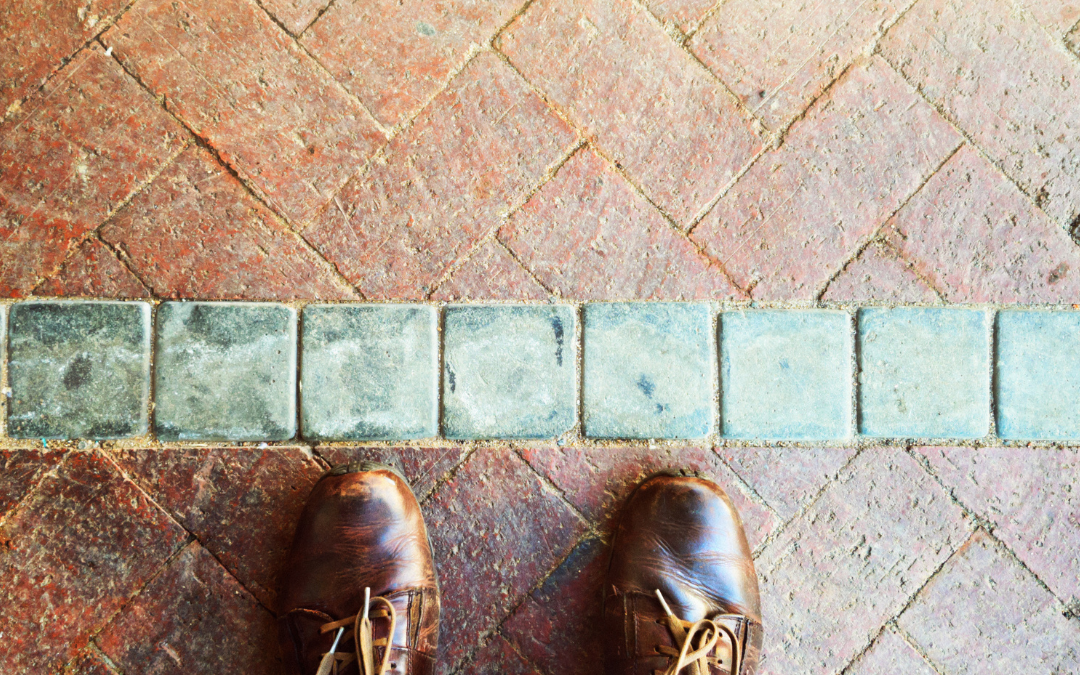
Mental Health and Emotional Wellness
In today’s fast-paced world, where the lines between work, family, and personal time often blur, setting
healthy boundaries has become more crucial than ever. This is especially true for parents and caregivers who are constantly navigating the needs of others while trying to maintain their own mental health and self-care routines.
Understanding Healthy Boundaries
Healthy boundaries are the invisible lines that define our personal space, both emotionally and physically. They help protect our well-being by delineating what is acceptable and unacceptable in our interactions. Setting these boundaries is a form of self-care that everyone should prioritize.

Why Healthy Boundaries Are Important
- Protects Mental Health: Establishing boundaries helps reduce stress and prevent burnout by ensuring that you are not overextending yourself. It allows you to focus on what truly matters without feeling overwhelmed.
- Enhances Relationships: Healthy boundaries foster respect and understanding in relationships. You cultivate mutual respect and stronger connections by clearly communicating your needs and limits.
- Supports Self-Care: Boundaries are a critical component of self-care, allowing you to allocate time and energy to activities that rejuvenate and fulfill you.
- Empowers Personal Growth: Setting boundaries encourages self-reflection and confidence, empowering you to take control of your life and make decisions that align with your values.
Steps to Setting Healthy Boundaries
- Self-Reflection
Begin by reflecting on your current boundaries or lack thereof. Consider areas where you often feel discomfort, resentment, or exhaustion. These feelings can signal the need for boundary-setting.
- Define Your Limits
Clearly identify what you need to protect your mental health and well-being. This could include time alone, saying no to additional responsibilities, or limiting specific interactions.
- Communicate Clearly
When discussing boundaries, use clear and assertive communication. Express your needs in a straightforward manner without apologizing or justifying them. For example, “I need some time to myself after work to unwind” is effective and respectful.

- Be Consistent
Consistency is vital when enforcing boundaries. Be firm yet empathetic when reminding others of your limits. Over time, people will learn to respect your space and needs.
- Practice Self-Care
Regularly check in with yourself to ensure that others respect your boundaries and that you honour your self-care commitments. Remember, boundaries are flexible and can be adjusted as your needs change.
- Seek Support
If you’re struggling to set boundaries, consider seeking support from mental health professionals or joining communities focusing on boundary-setting and self-care. Resources like Brené Brown’s workbooks and discussion guides can provide valuable insights and tools.
Conclusion
Setting healthy boundaries is essential for protecting your mental health and fostering relationships and personal growth. You empower yourself to lead a balanced and fulfilling life by prioritizing boundaries.
Ready to take the next step in your boundary-setting journey? Connect with like-minded individuals in our community or explore resources that can help you refine this crucial skill. Remember, setting boundaries is an act of self-love and empowerment.
Therapy Options Explained
Undergoing surgery is a significant event that can impact your physical and emotional well-being. While the procedure may be necessary for your health, recovery can often feel daunting. But with the proper support, particularly from a skilled physiotherapist, and a solid post-surgery rehabilitation program you can regain your independence and return to your daily activities more efficiently.
The Role of Physiotherapy in Post-Surgery Rehabilitation
Physiotherapy is a crucial component of post-surgery rehabilitation. It focuses on restoring movement, improving strength, and reducing pain to help patients get back on their feet. Here’s how physiotherapy can aid in your recovery:

- Personalized Exercise Plans
Every surgical procedure and patient is unique, so physiotherapists create tailored exercise programs. They design these plans to meet your needs and recovery goals, ensuring safe and effective rehabilitation.
- Pain Management
Post-operative pain can hinder your progress. Physiotherapists use techniques such as manual therapy and targeted exercises to alleviate pain and discomfort, helping you move more freely.
- Improving Mobility and Strength
A primary goal of physiotherapy is to improve mobility and regain strength. Through structured exercises and therapies, physiotherapists focus on enhancing the function of the affected area, which is critical for restoring your independence.
- Preventing Complications
Prolonged immobility can lead to complications such as blood clots or muscle atrophy. Engaging in a physiotherapy program can help prevent these issues by promoting circulation and maintaining muscle tone.
What to Expect from Post-Surgery Rehabilitation Sessions
When you begin your post-surgery rehabilitation program, your physiotherapist will thoroughly assess your condition, surgery details, and personal goals. Here’s what a typical session might involve:
- Assessment – Evaluating your current range of motion, pain levels, and overall condition.
- Goal Setting – Establishing achievable milestones to keep you motivated and on track.
- Treatment Plan – Implementing exercises, manual therapy, and other treatments tailored to your needs.
- Progress Monitoring – Regularly reviewing your progress and adjusting your plan as necessary to ensure optimal recovery.

Tips for Maximizing Your Rehabilitation Success
- Be Consistent – Attend all scheduled physiotherapy sessions and perform any recommended exercises at home.
- Communicate Openly – Keep your physiotherapist informed about any pain or difficulties you experience.
- Stay Positive – Recovery can be challenging, but maintaining a positive mindset is crucial for success.
- Follow Post-Op Guidelines – Adhere to any restrictions or instructions provided by your surgeon and physiotherapist.
For Caregivers
If you’re caring for someone recovering from surgery, your support is essential to their rehabilitation. Encourage them to follow their physiotherapy plan, assist with exercises if needed, and ensure they’re comfortable and supported during this time.
Conclusion
Physiotherapy is an invaluable tool for anyone looking to regain independence after surgery. Working closely with a physiotherapist ensures your recovery is efficient, safe, and tailored to your needs. Don’t hesitate to explore the benefits of physiotherapy as part of your post-surgery rehabilitation process.
Ready to take the first step toward your recovery? Book an appointment with a qualified physiotherapist today and start your journey to reclaim your independence.

Mental Health and Emotional Wellness
Many individuals explore various methods to achieve personal growth and fulfillment in today’s fast-paced world. Among these, hypnotherapy is gaining popularity as a powerful tool for manifestation—a process of bringing your desires and aspirations into reality. Understanding how hypnotherapy can aid manifestation might be your next step toward creating the life you want.
Understanding Hypnotherapy and Manifestation
What is Hypnotherapy?
Hypnotherapy is a form of talk therapy that involves guided relaxation and focused attention to achieve a heightened state of awareness. During this state, individuals are more open to suggestions, making it an effective method for addressing subconscious beliefs and patterns hindering personal growth.

What is Manifestation?
Manifestation is bringing something tangible into your life through attraction and belief. It’s about aligning your thoughts, feelings, and actions to bring positive changes and fulfill your desires. Often, manifestation incorporates positive affirmations and visualization techniques to amplify its effects.
How Hypnotherapy Enhances Manifestation
- Breaking Down Mental Barriers
One of the primary ways hypnotherapy aids manifesting the life you want, is by breaking down mental barriers. Often, subconscious blocks—such as limiting beliefs or negative thought patterns—can hinder your ability to manifest your goals. These barriers can be identified and reprogrammed through hypnotherapy, allowing for a clearer path to manifesting your desires.
- Reinforcing Positive Affirmations
Positive affirmations are a key component of manifestation. They help shift your mindset toward positivity and possibility. A hypnotherapist can help you reinforce these affirmations more deeply, reaching the subconscious mind where lasting change occurs. This reinforcement helps solidify new, empowering beliefs that support your manifestation goals.

- Visualizing Success
Visualization is another powerful tool in the process. It involves creating vivid mental images of your desired outcome. During hypnotherapy, visualization exercises can help you to experience the feelings and sensations associated with achieving your goals. This practice boosts confidence and increases motivation to take action toward those goals.
- Aligning Subconscious and Conscious Mind
For manifestation to be effective, your conscious desires must align with your subconscious beliefs. Hypnotherapy facilitates this alignment by bringing subconscious thoughts to the surface and addressing conflicts between the two. Once aligned, your intentions become more powerful, paving the way for successfully manifesting your dreams.

Getting Started with Hypnotherapy for Manifestation
Many individuals have reported tangible results from using hypnotherapy for manifesting their goals. The potential benefits are vast, from career advancements to improved relationships and financial success. By committing to regular hypnotherapy sessions and incorporating manifestation techniques into daily life, many find themselves closer to realizing their dreams.
If you’re interested in exploring hypnotherapy as a tool to manifest the life you want, consider the following steps:
- Research Qualified Practitioners: Look for certified hypnotherapists with experience in manifestation techniques.
- Set Clear Intentions: Define what you want to manifest and keep these intentions clear and specific.
- Commit to Regular Sessions: Consistency is vital. Regular hypnotherapy sessions can reinforce positive changes and keep you on track.
- Practice Daily Affirmations and Visualization: Incorporate these practices into your routine to support the work done in hypnotherapy.
Conclusion
Hypnotherapy offers a unique and practical approach to manifestation, empowering you to overcome subconscious blocks and align your mind with your deepest desires. By integrating hypnotherapy into your personal development journey, you can enhance your ability to manifest the life you truly want. Ready to take the next step? Explore hypnotherapy for manifestation today and unlock your full potential.
Written by DeVera Nybo, Owner, Newleaf Total Wellness Centre
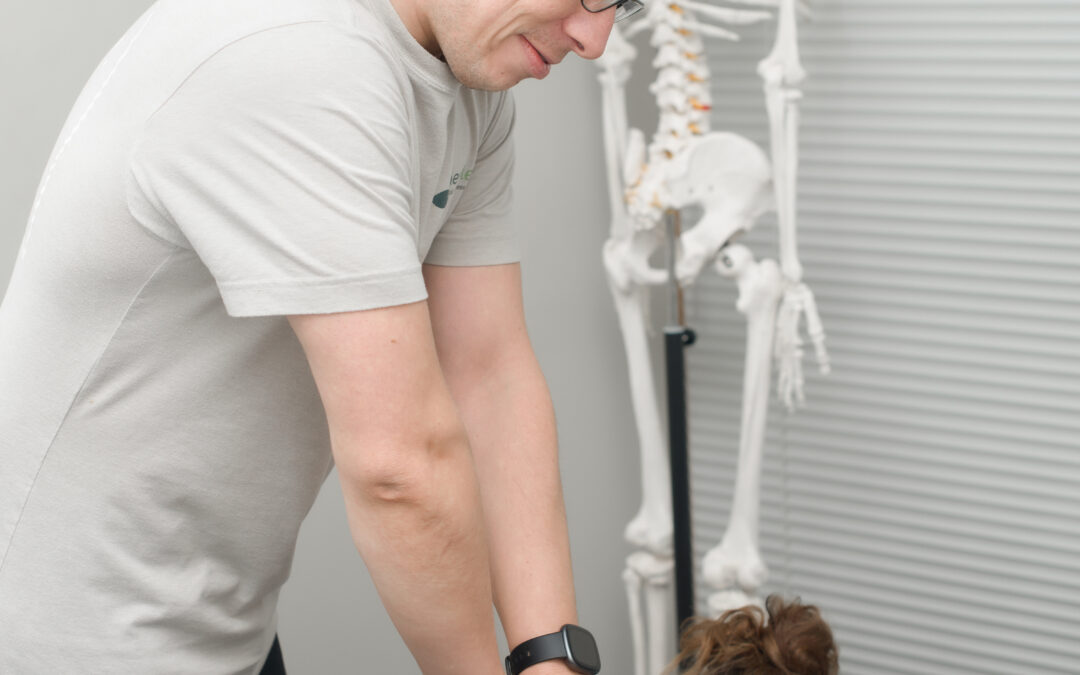
Therapy Options Explained
Chiropractic care has been a source of both relief and skepticism for many seeking solutions to their back pain. However, misconceptions often cloud the actual benefits of this health practice. If you’re curious about chiropractic treatment or are considering it as a solution for your back pain, it’s essential to separate fact from fiction.

What is Chiropractic Care?
Before we tackle the myths, let’s clarify what chiropractic care involves. Chiropractors focus on diagnosing and treating mechanical disorders of the musculoskeletal system, especially the spine. Through manual adjustment or manipulation, they aim to improve spinal function and alleviate stress on the body’s systems, enhancing overall health.
Common Myths
Myth 1: Chiropractors Aren’t Real Doctors
One of the most prevalent misconceptions is that chiropractors aren’t legitimate healthcare providers. In truth, chiropractors undergo extensive education and training, similar to medical doctors. They earn a Doctor of Chiropractic (DC) degree, which requires at least four years of advanced study, including clinical training.
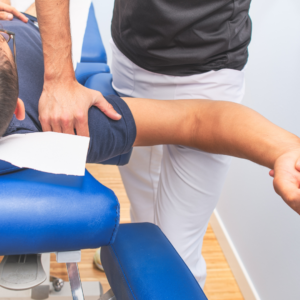
Myth 2: Chiropractic Care Is Only for Back Pain
While chiropractors are well-known for addressing back pain, their expertise extends far beyond. They can treat conditions such as neck pain, headaches, and musculoskeletal disorders and offer advice on nutrition and lifestyle changes to improve overall health.
Myth 3: Adjustments Are Dangerous
Another common myth is that adjustments can be harmful. When performed by a licensed chiropractor, these treatments are safe and effective. Chiropractors get extensive training and education on minimizing discomfort while maximizing relief.

Myth 4: Once You Start, You Have to Keep Going Forever
Many people believe that you must continue chiropractic treatment indefinitely once you begin. While some may benefit from ongoing care, many patients find substantial relief after a short series of treatments. Your chiropractor will work with you to design a personalized care plan based on your needs and goals.
Myth 5: Chiropractic Care Isn’t Supported by Science
Some skeptics argue that chiropractic lacks scientific backing. However, numerous studies have demonstrated its effectiveness in treating back pain and other conditions. Research shows that it can significantly reduce pain and improve function, offering a valid alternative or complement to traditional medical interventions.

The Benefits of Chiropractic Care
Understanding the benefits of chiropractic care can help dispel these myths:
- Back Pain Relief: Adjustments can reduce pain and improve mobility for chronic back issues.
- Non-Invasive: Unlike surgical options, chiropractic treatments are non-invasive, minimizing recovery time and risk.
- Whole-Body Wellness: Chiropractors often take a holistic approach, addressing lifestyle factors and recommending exercises to support long-term health.
Is Chiropractic Care Right for You?
Chiropractic care might be worth considering if you’re struggling with back pain or other musculoskeletal issues. It’s advisable to consult with a qualified chiropractor who can assess your condition and provide a tailored treatment plan. Remember, informed decisions about your health should be based on facts, not myths.
For those curious about the potential benefits of seeing a chiropractor, taking the first step towards consultation can be a game-changer in your health journey. Whether you’re a health enthusiast or someone dealing with persistent pain, understanding the truths behind chiropractic care can open doors to improved well-being.

Mental Health and Emotional Wellness
People often misinterpret perfectionism as striving to be the best, but it is more complex. Brene Brown describes it as believing that achieving perfection in our actions, appearance, and life can protect us from criticism, blame, and shame. Despite its promise of protection, perfectionism often results in stress, anxiety, and self-doubt.
Defining Perfectionism
Perfectionism extends beyond high standards to an all-or-nothing mindset where falling short of flawless is unacceptable. This mentality can affect various life areas, such as work and relationships, leading to dissatisfaction and a fear of failure. Trying to be perfect is not self-improvement. Perfectionism is, at its core, about trying to earn approval. Brown also warns, “Perfect and bulletproof are seductive, but they don’t exist in the human experience.” Acknowledging this is the first step toward overcoming perfectionism.

The Dangers of Perfectionism
While pursuing excellence can fuel success, trying to be perfect can be crippling, often leading to:
- Procrastination: The fear of falling short of perfection can delay the initiation or completion of tasks.
- Mental Health Issues: Persistent self-criticism and fear of judgment contribute to anxiety, depression, and feelings of inadequacy.
- Relationship Strain: Expectations can extend to others, causing frustration and conflict.
- Decreased Productivity: Focusing excessively on details can impede task completion and stifle creativity.
- Shame: Perfectionism is shame avoidance. Shame is a universally uncomfortable emotion that creates fear that we are unworthy of connection. However, because perfection is unattainable, shame ultimately follows us on our quest for perfection.

Identifying Perfectionism
Recognizing signs of perfectionism is essential. If you frequently struggle to meet your own standards, feel anxious or frustrated trying to fulfill them, or hear that your standards are too high, perfectionistic tendencies might be the issue.
Reflective Questions:
- Do I find it difficult to meet my standards?
- Am I often anxious or frustrated in trying to meet them?
- Have others remarked that my standards are excessively high?
- Do my standards prevent me from completing tasks or enjoying life?
- Am I critical of others who fail to meet my high expectations?
- Do I have different expectations for myself than I do for others?

Examples of Perfectionist Thoughts and Behaviors
Perfectionist Feelings:
- Feeling anxious or depressed when unable to meet self-imposed expectations.
- Engaging in constant self-criticism despite putting in effort and time.
- Feeling ashamed or uncomfortable with compliments.
Perfectionist Thinking:
- Black-and-white thinking: Viewing anything less than perfect as a failure.
- Catastrophic thinking: Assuming the worst will happen if you make a mistake.
- Should Statements: Believing you must always be perfect and never show weakness.
Perfectionist Behavior:
- Chronic procrastination or giving up when tasks aren’t perfect.
- Excessive checking for errors or unnecessarily redoing work.
- Avoiding new experiences to prevent mistakes.

Strategies to Overcome Perfectionism
a) Realistic Thinking vs Perfectionism
Replace negative, self-critical thoughts with realistic, positive affirmations. Consistent practice can foster new thought patterns.
Examples:
“Nobody is perfect!”
“All I can do is my best!”
“Making a mistake is human.”
b) Perspective Taking
Challenge distorted perspectives by considering others’ viewpoints. Ask yourself:
- How would a friend see this situation?
- Are there alternative perspectives?
c) Consider the Big Picture
Redirect your focus from details to broader perspectives by asking:
- What’s the worst that could happen?
d) Compromising vs Perfectionism
Establish flexible, realistic standards and be open to compromise.

Moving Forward
Overcoming perfectionism involves accepting imperfections and valuing progress over flawlessness, not lowering your standards. By practicing these strategies and acknowledging perfection’s unrealistic nature, you can lead a more fulfilled, balanced life.
If you’re ready to address your perfectionism further, consider professional guidance. Engage with mental health professionals, join support groups, or read insightful books to support your self-improvement. While perfection may be an illusion, growth and happiness are attainable.
Written by: DeVera Nybo, Owner, Newleaf Total Wellness Centre

Healthy Habits & Lifestyle
Have you ever found yourself saying, “I’m so tired.” even after a full night’s sleep? You’re not alone. Many adults struggle with feeling refreshed upon waking, and the reasons can be as multifaceted as they are frustrating.
Understanding the complexities of sleep can seem daunting, but rest assured—it’s not impossible. Let’s unravel why you might not feel rested and how you can harness the power of routines to transform your night into a more restful experience.
The Sleep Deprivation Cycle
Sleep deprivation is more common than we think. According to the CDC, 1 in 3 adults don’t get enough. But what causes this cycle of tiredness even when we believe we’re getting enough shut-eye?
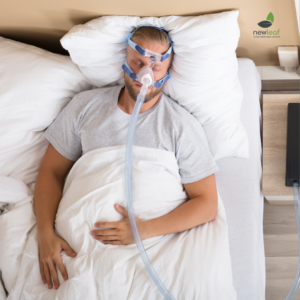
-
Sleep Disorder Suspects
Conditions like sleep apnea or insomnia might be the culprits. Sleep apnea disrupts breathing, causing interruptions throughout the night, while insomnia prevents you from falling or staying asleep. Both can leave you exhausted despite spending 7-8 hours in bed.
-
Poor Sleep Hygiene
Good sleep hygiene—habits and practices that promote consistent, uninterrupted slumber—is crucial. If your nightly routine includes late-night caffeine, irregular schedules, or blue light exposure before bed (yes, your phone or the TV), these habits might sabotage your restful night.

-
Stress and Mental Health
Mental health significantly impacts the quality of a good night’s rest. Anxiety and stress can keep your mind active, making it difficult to relax and drift into deep sleep phases essential for feeling rested.
How to Achieve Restful Sleep
With the right strategies, you can improve your chances of waking up refreshed. Here’s how:
-
Revamp Your Sleep Hygiene
- Consistent Schedule: Go to bed and wake up at the same time every day, even on weekends. Consistency helps regulate your body’s internal clock.
- Create a Bedtime Routine: Engage in relaxing activities like reading or listening to music before bed. Avoid screens at least an hour before you retire for the night.
- Optimize Your Environment: Ensure your bedroom is dark, quiet, and cool. Consider blackout curtains and white noise machines if needed.

-
Evaluate Your Sleep Quality
Monitor your sleep patterns using apps or sleep trackers. They can provide insights into how often you wake up during the night or the length of your sleep cycles.
-
Address Physical and Mental Health
Consult with a healthcare professional if you suspect a disorder or if stress and anxiety are affecting your ability to get a good night’s rest. Treatment options and therapy can make a significant difference.
-
Diet and Exercise
Maintain a balanced diet and regular exercise regimen. Both can enhance sleep quality. However, avoid heavy meals and vigorous activity close to bedtime.

Conclusion
Feeling perpetually tired can be disheartening, but understanding the root causes and adopting healthier habits can help you reclaim restful nights. Prioritize your sleep hygiene and consider professional advice if necessary.
Remember, a well-rested you is a more productive, happier you. Take the first step towards transforming your life today!
For more tips on healthier lifestyles, subscribe to our blog posts and join our community of health enthusiasts committed to wellness and self-care.
Pain Relief and Physical Health
In today’s digital age, the relentless clicking, typing, and scrolling can take a toll on our hands and forearms. Whether you’re a dedicated gamer, an office worker glued to your desk, or simply someone who values massage therapy, prioritizing hand and forearm care is essential. Let’s explore why massaging your hands and forearms, especially your mouse hand, can be a game-changer for ergonomic health and gaming comfort.
The Hidden Stress in Your Hands and Forearms
The repetitive motions associated with prolonged computer use or gaming can lead to tension and strain in your hands and forearms. This stress can result in discomfort, reduced mobility, and even issues like carpal tunnel syndrome. While ergonomic keyboards and mice can help, they don’t eliminate the strain entirely.
The Role of Hand and Forearm Massage
Regular hand and forearm massages can alleviate tension, improve circulation, and promote overall ergonomic health. Here’s how:
- Relieves Muscle Tension: Massaging the hands and forearms helps release tight muscles, reducing pain and stiffness.
- Enhances Blood Flow: By stimulating circulation, massage delivers oxygen and nutrients to the muscles, aiding recovery and promoting healing.
- Improves Flexibility: Regular massage therapy increases joint flexibility and hand mobility, which is essential for typing and gaming.
- Reduces Stress: Beyond physical benefits, massage is known for its relaxing effects, helping to reduce stress and promote mental well-being.

Benefits for Gamers’ Hands and Forearms
For gamers, hand and forearm massages offer specific advantages:
- Increased Gaming Comfort: Reducing tension and discomfort enhances your gaming experience, allowing more extended and enjoyable play sessions.
- Enhanced Performance: Improved circulation and flexibility can improve reaction times and overall performance in fast-paced games.
- Prevention of Injuries: Regular massage can prevent repetitive strain injuries, keeping you in the game longer without pain.
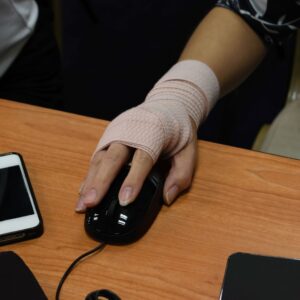
Office Workers’ Hand and Forearm Health
Office workers, too, can benefit significantly from regular hand and forearm massages:
- Improved Productivity: Reducing discomfort allows for more focused work, increasing daily productivity.
- Enhanced Comfort: A massage helps alleviate the aches and pains of prolonged desk work, improving overall comfort.
- Long-Term Health: Regular massages can help prevent long-term issues, such as carpal tunnel syndrome, by maintaining muscle and joint health.
Massage Enthusiasts’ Perspective
Massage enthusiasts already appreciate the benefits of bodywork, and hands and forearms are no exception. Incorporating these areas into regular massage routines:
- Completes the Experience: Addressing often-overlooked areas like the hands and forearms can provide a more holistic massage experience.
- Enhances Relaxation: Adding hand and forearm massage to your routine can further deepen the relaxation and therapeutic benefits.
Integrating Hand and Forearm Massage into Your Routine
Whether you choose a professional massage therapist or learn self-massage techniques, incorporating hand and forearm massages into your routine is simple. Consider setting aside time each week to focus on these areas by booking a session or using tools like massage balls or rollers.

Conclusion
Incorporating hand and forearm massage into your life is a simple yet effective way to enhance ergonomic health and gaming comfort. By making it a regular part of your routine, you can enjoy increased comfort, improved performance, and better overall well-being. Don’t wait until discomfort sets in—take proactive steps to care for your hands and forearms today.
Ready to experience the benefits for yourself? Book a massage session today or explore self-massage techniques to start feeling the difference. Your hands and forearms will thank you!
Written By: DeVera Nybo, MBA, Owner Newleaf Total Wellness Centre

Pain Relief and Physical Health
Patients want to get better faster, but they often find themselves waiting for treatments to work their magic. The reality is that effective healthcare requires active participation. This partnership between practitioners and patients is crucial for achieving the best outcomes, and this is where understanding and adhering to the Patients’ Charter of Rights and Responsibilities becomes essential in your path to getting better faster.

Patients’ Charter : A Key to Get Better Faster
The Patients’ Charter is a documented agreement that outlines the rights and responsibilities of patients within the healthcare system. It fosters a partnership of care, ensuring everyone involved understands their roles. By adhering to this charter, patients can significantly enhance their treatment experience and outcomes, ultimately helping them get better faster.
Rights of Patients
Before discussing responsibilities, let’s acknowledge patients’ rights, which protect them and ensure that practitioners deliver care with dignity and respect. These rights empower you to advocate for yourself within the healthcare system, facilitating a faster recovery:
- Right to Informed Consent: Ensures you receive complete and understandable information about your treatment options, enabling you to make informed decisions.
- Right to Privacy and Confidentiality: Protects your personal health information, ensuring it’s only disclosed with your consent or as required by law.
- Right to Respect and Dignity: Entitles you to respectful and considerate care, regardless of your background or condition.

Patient Responsibilities for Getting Better Faster
Effective healthcare is a two-way street. To get better faster, you must engage actively with your healthcare providers. Here are your essential responsibilities:
- Cooperative Commitment to Your Treatment Plan: A successful healthcare experience requires a genuine commitment to the treatment plan outlined by your provider:
- Compliance with Office Policies and Procedures: Adhere to the healthcare facility’s guidelines, including appointment schedules and payment of fees.
- Honest Disclosure of Health Information: Provide accurate and complete information about your health history, current symptoms, and medications or supplements you take.
- Active Participation in Your Recovery: Your recovery is not passive. To optimize results and get better faster, you must:
- Follow Home Exercises and Medication Regimens: Compliance with prescribed exercises, medications, and supplements is critical to your treatment and recovery.
- Provide Constructive Feedback: Share honest feedback about your treatment experience to help healthcare providers tailor their care to suit your needs better.
- Respect for the Healthcare Environment: Maintain a respectful attitude towards the office environment, staff, and fellow patients, creating a positive atmosphere conducive to healing.
- Keep Your Contact Information Up-to-Date: Ensure your healthcare provider has your contact information to facilitate communication and scheduling.

The Equal Role of Practitioners and Patients
Remember, treatment is a collaborative effort. Both you and your practitioner have equal roles in your recovery and rehabilitation. While healthcare professionals provide expertise and guidance, they cannot “make you well” alone. You must actively participate in your health and well-being to get better faster.
Conclusion
A successful healthcare experience is built on mutual understanding and cooperation between patients and practitioners. By recognizing your rights and fulfilling your responsibilities outlined in the Patients’ Charter, you can become an empowered partner in your care, ultimately getting better faster.
For more guidance on actively participating in your treatment plan, or if you have any questions about your rights and responsibilities, please get in touch with us or book an appointment with our Patient Care Coordinator today. Together, we can achieve the best possible outcomes through a strong partnership of care.
Written by: DeVera Nybo, MBA, Owner Newleaf Total Wellness Centre

Therapy Options Explained
When managing our health and well-being, making informed care decisions is crucial. Yet, the sheer volume of healthcare options can be overwhelming. This is where Newleaf Total Wellness Centre steps in—committed to simplifying this process for patients like you. At Newleaf Total Wellness Centre, we offer more than just a multidisciplinary clinic; we embody an interdisciplinary approach where comprehensive patient care forms our foundational ethos. Our mission is to deliver evidence-informed treatment coupled with patient-centred care, empowering you to become Stronger, Braver, and Better.
Working With a Patient Care Coordinator to Determine Healthcare Options
Imagine entering a world where your health concerns are met with attentive care from the outset. At Newleaf Total Wellness Centre, that’s what you experience with our Patient Care Coordinator (PCC)—your personalized healthcare concierge putting your needs first.
Upon arrival, our PCC conducts a comprehensive initial evaluation. This conversation is the first step in navigating the complex maze of healthcare pathways. Following this assessment, the PCC will make treatment recommendations based on your needs, expectations and personality – finding a practitioner or team of practitioners that best fits you. This seamless collaboration allows us to craft a comprehensive, individualized treatment plan that may involve one or multiple practitioners from our facility.

The Commitment to Patient-Centered Care
At the heart of Newleaf Total Wellness Centre’s philosophy lies an unwavering commitment to being patient-centric. It’s about listening, understanding the nuances of your health concerns, and partnering with you on your healing journey. Newleaf Total Wellness Centre stands as a testament to the power of integrating disciplines, breaking down the silos commonly found in healthcare to deliver care that genuinely resonates with our patients’ aspirations for wellness.
By joining the Newleaf Total Wellness Centre community, you’re not just choosing treatment but empowering yourself with knowledge and care tailored to you. Through our collaborative spirit and dedication to excellence, we guide you toward becoming a healthier, stronger version of yourself.

A Closer Look at Our Patient Care Coordination Services
Tailored Support for ICBC Patients
For ICBC patients seeking a structured, efficient pathway to recovery, our PCC service is here to empower them with the knowledge and resources to regain their strength and well-being.
- Accident Details Review: Our PCC will review your accident details to tailor your recovery plan.
- Healthcare Options: Get informed about the treatments available to aid your recovery.
- Clinic Orientation: Familiarize yourself with our offerings and procedures.
- Appointment Coordination: Ensure seamless care by booking and coordinating your appointments.

Dedicated Care for WorkSafe BC Patients
This service caters to WSBC patients, providing injured workers with an overview of assessment and treatment plans, rehabilitation protocols, and the Return-to-Work process.
- Informed Consent & Program Review: Understand expectations and policies clearly.
- Clinic Tour: Get acquainted with our facilities and services.

Comprehensive Support for Chronic Pain and Complex Medical Needs
Our PCC will:
- Initial Consultation: Meet to obtain a brief patient history and understand your health challenges.
- Needs Evaluation: Assess and suggest an optimal course of action.
- Healthcare Options: Get informed about the treatments available to aid your recovery.
- Appointment Scheduling: Assist in booking specialists and ensuring continuity of care.

General Patient Service Choice Consultation
For new patients, this consultation helps you decide which services best your needs.
- Service and Practitioner Selection: Choose the right service and practitioner for effective, personalized care.
- Free Consultation: Receive expert advice without cost.
- Healthcare Options: Get informed about the treatments available to aid your recovery.
- Time and Money Savings: Direct you to the most appropriate services to avoid unnecessary expenses.
Conclusion
Choosing Newleaf Total Wellness Centre means opting for a center that has mastered the art of interdisciplinary care, ensuring every patient’s story is heard and their health goals are met with unmatched expertise. Ed, DeVera and the entire Newleaf team invite you to experience the quality of care that defines our legacy of support and strength.
Are you ready to take control of your well-being and chart a course for better health? It’s time to turn over a new leaf at Newleaf Total Wellness Centre—where we nurture your strength and bravery, and you become better, one healing step at a time.
To learn more about how we can assist you in your health and wellness journey, contact us at Newleaf Total Wellness Centre. Our doors are open to welcome you into our healing space.

Therapy Options Explained
In the ever-expanding world of alternative medicine, ear seeding has emerged as a fascinating and effective method for promoting overall wellness. But what exactly is ear seeding, and why is it gaining popularity among wellness enthusiasts and seekers of alternative therapies?

The History and Origins of Ear Seeding
Ear seeding, or auriculotherapy, is deeply rooted in Traditional Chinese Medicine (TCM). This practice goes back thousands of years and is based on the concept that the ear is a microsystem of the entire body. By stimulating specific points on the ear, practitioners believe they can influence various bodily functions and promote overall health.
How Does it Work?
Auriculotherapy involves placing tiny seeds or beads on specific ear points. These seeds are typically held in place with adhesive tape and are known to stimulate acupressure points. This stimulation directly impacts the body’s energy flow or “Qi,” helping to restore balance and enhance well-being.
Research and clinical studies have shown that ear seeding can influence the nervous system, reduce pain, and improve emotional well-being, making it a versatile tool in holistic health care.

Benefits of Ear Seeding for Wellness and Health
The benefits of auriculotherapy extend across various wellness and health areas. Some of the most notable include:
Pain Relief: Many individuals report significant reductions in chronic pain conditions, including migraines and arthritis.
Stress Reduction: Research has found auriculotherapy to promote relaxation and reduce stress levels, making it an excellent tool for mental well-being.
Enhanced Sleep: By balancing energy flow, ear seeding can help those struggling with insomnia or poor sleep quality.
Digestive Support: It can aid in improving digestion and easing symptoms of gastrointestinal disorders.
Emotional Balance: Many users find auriculotherapy helps manage anxiety, depression, and other emotional challenges.
Who Can Benefit?
Auriculotherapy is a versatile therapy suitable for a diverse range of individuals:
Chronic Pain Sufferers: Those with migraines, back pain, or arthritis may find relief.
Individuals Under Stress: Anyone experiencing high stress or anxiety levels could benefit from the calming effects of auriculotherapy.
Sleep-Deprived Individuals: Those looking to improve their sleep patterns can find ear seeding especially useful.
Wellness Seekers: Individuals invested in maintaining their overall health and wellness often add ear seeding to their holistic health regimen.

The Process of Ear Seeding: What to Expect
If you’re considering ear seeding, understanding the process can help set your expectations:
Initial Consultation: A practitioner will assess your health and determine which points on your ear need stimulation.
Application: Adhesive tape applies small seeds or beads to the identified points.
Duration: Seeds typically remain in place for several days to a week, after which the TCM will remove or replace them.
Follow-Up: Regular follow-ups ensure the treatment remains effective.
Safety and Effectiveness
Ear seeding is generally safe when performed by a trained practitioner. It is non-invasive and has minimal side effects, making it suitable for most individuals. However, it is essential to consult a certified professional to ensure the practice is tailored to your specific needs and health conditions.

Ear Seeding vs. Other Alternative Therapies
Compared to other alternative therapies like acupuncture, reflexology, or herbal medicine, ear seeding stands out for its simplicity and accessibility. While acupuncture involves needles and requires professional administration, ear seeding can be self-administered with proper guidance.
Conclusion
As the world continues to explore and embrace holistic approaches to health, auriculotherapy plays a significant role in the future of wellness. Its ancient roots and modern validation make it a reliable and accessible tool for achieving better health.
At Newleaf Total Wellness Centre, we offer evidence-informed treatments that prioritize patient-centered care. Our interdisciplinary team is committed to working together to help you achieve your wellness goals. If you’re interested in exploring ear seeding or other alternative therapies, we invite you to connect with us and take a proactive step toward a higher quality of life.
Written by: DeVera Nybo, MBA, CEO / Owner Newleaf Total Wellness Centre

Chronic Conditions & Holistic Health
Feeling nauseous can be an uncomfortable and disruptive experience. Many health-conscious individuals seek to understand the underlying causes and solutions for this common problem. In this blog post, we’ll explore the various factors that can lead to nausea, its physiology, management strategies, diagnostic processes for chronic nausea, and holistic treatments that can offer relief.

What Causes Nausea?
Various factors can trigger nausea, ranging from benign to more serious health conditions. Common causes include:
- Gastrointestinal Issues: Conditions such as gastroenteritis, food poisoning, and acid reflux can one lead to feeling nauseated.
- Motion Sickness: Traveling by car, plane, or boat can trigger upset stomach and vomiting in susceptible individuals.
- Pregnancy: Morning sickness is a well-known cause of nausea during pregnancy.
- Medication Side Effects: Certain medications, such as chemotherapy drugs, can induce nausea as a side effect.
- Stress and Anxiety: Emotional stress and anxiety can manifest physically as queasiness.
- Food Sensitivities: Food intolerances and allergies can cause stomach upset after consuming trigger foods.
The Physiology Behind Nausea
Feeling nauseous is a complex physiological response that involves multiple body systems. It begins in the brain, specifically the area known as the vomiting center, which receives input from various sensory organs such as the inner ear and stomach. This triggers a series of events, including increased heart rate, changes in blood flow, and contraction of abdominal muscles, resulting in the sensation of queasiness sometimes leading to vomiting.

Managing Nausea
Managing nausea involves addressing both the symptoms and the underlying cause. Here are some strategies that can help:
- Dietary Changes: Avoiding trigger foods or following an anti-inflammatory diet can help. Eating smaller, more frequent meals and avoiding spicy or greasy foods can reduce nausea.
- Hydration: Staying hydrated helps flush out toxins and can alleviate symptoms.
- Ginger and Peppermint: Research has shown that natural remedies like ginger tea or peppermint oil can reduce queasiness.
- Medication: Over-the-counter antiemetic medications can provide temporary relief in acute cases.
- Mindfulness and Relaxation Techniques: Reducing stress through mindfulness and relaxation exercises can help manage anxiety-related nausea.

How is Chronic Nausea Diagnosed?
When nausea becomes chronic, a thorough evaluation by a healthcare professional is essential. According to the Mayo Clinic, effective treatment relies on accurate diagnosis. The diagnostic process may include:
- Medical History Review: Understanding the patient’s medical history and current medications.
- Physical Examination: A comprehensive physical examination to identify potential underlying conditions.
- Diagnostic Tests: Doctors may conduct blood tests, imaging, and endoscopy to rule out specific causes.
A precise diagnosis can significantly improve treatment outcomes, offering targeted solutions to manage chronic nausea.

Holistic Treatments for Chronic Nausea
Holistic approaches can complement traditional medical treatments, providing a comprehensive strategy for managing chronic nausea. These include:
- Acupuncture: This ancient practice can help balance energy flow and reduce symptoms.
- Herbal Remedies: Herbs like chamomile and fennel are known for their soothing properties.
- Dietary Counseling: Working with a nutritionist to create a tailored diet plan can support overall wellness and reduce nausea.
At Newleaf Total Wellness Centre, we believe in a patient-centred approach that integrates interdisciplinary care to achieve optimal health outcomes. Our team of professionals is dedicated to supporting your journey to feeling stronger, braver, and better.

Conclusion
Understanding the causes and physiology of nausea is the first step in finding effective relief. Individuals can take proactive steps toward better health by exploring various management strategies, diagnostic processes, and holistic treatments. Consider partnering with a healthcare provider who values evidence-informed, patient-centred care for personalized support.
If you’re experiencing chronic nausea and would like to explore holistic treatment options, contact Newleaf Total Wellness Centre. Our team of experts is here to partner with you on your path to wellness.
Written by: DeVera Nybo, MBA, CEO / Owner Newleaf Total Wellness Centre

Mental Health and Emotional Wellness
Hard emotions can feel like a storm that appears out of nowhere. One minute, you’re going about your day, and the next, you’re overwhelmed by feelings of anger, sadness, or anxiety. While pushing them away is tempting, the key to emotional wellness is acknowledging and processing these emotions. Let’s explore how to approach these feelings with compassion and understanding so they can pass without leaving a lasting impact.
1. Engage with Your Feelings
The first step in managing hard emotions is to engage with them fully. This doesn’t mean letting them take over your life but acknowledging their presence. You create a space where healing can begin by allowing yourself to feel without judgment. Remember, emotions are transient—they will pass.

2. Get Curious About the Story
Every emotion has a story. When a feeling arises, instead of immediately reacting, pause and ask yourself, “What is this about?” Understanding the origin of your emotions can provide valuable insights into your triggers and patterns.
3. Write it Down
Journaling is a powerful tool for processing emotions. Write down your feelings and why you think you’re feeling that way. This practice helps clarify your thoughts and allows you to see your feelings from a different perspective.

4. Dig In
- What Are the Facts, and What Are My Assumptions?
Separate facts from assumptions. Often, our emotions are tied to stories we’ve created in our minds. By identifying the truth, you can reduce the intensity of your emotional response.
- What Do I Need to Know About the Others Involved?
Consider the role of others in your emotional landscape. Understanding their perspectives may shift your view and help alleviate some of the feelings you’re experiencing.
- What Am I Really Feeling? What Part Did I Play?
Dig deeper into your emotions. Are you truly angry, or is there underlying sadness or fear? Recognizing the source of your feelings can be liberating. Reflect on your actions and consider how they may have affected the situation.
5. Regulate, Don’t Suppress
Emotion regulation is about managing your feelings, not suppressing them. Techniques such as deep breathing, meditation, and physical activity can help you stabilize your mood. These practices enable you to respond to emotions healthily and productively.

6. Work with a Helping Professional
If your emotions feel overwhelming and difficult to manage on your own, consider seeking support from a professional. Therapists and counsellors can provide a safe space to explore your feelings and develop effective strategies for dealing with them.
In conclusion, remember that hard emotions are part of being human. They do not define you, nor do they have to control your life. By adopting a mindful approach to your feelings, you’ll find they pass quickly, making you stronger and more resilient. If you’re ready to take the next step towards emotional wellness, consider booking an appointment with a helping professional who can help guide you.
Written by: DeVera Nybo, MBA, CEO/ Owner Newleaf Total Wellness Centre

Women's and Children's Health
Becoming a new parent is a thrilling experience, filled with many firsts and precious moments. However, it also comes with its fair share of worries, especially regarding your baby’s health and development. One area that often raises concerns is the physical well-being of infants, particularly issues like torticollis and flat head syndrome. Understanding these conditions and knowing when to seek professional help can significantly impact your baby’s growth and comfort.
Physiotherapy can be a game-changer for addressing physical ailments from an early age. If you’ve noticed that your baby has difficulty turning their head or has developed a flat spot on their head, visiting a physiotherapist can be highly beneficial. Early intervention can prevent long-term issues and promote healthy development.
What are Torticollis and Flat Head Syndrome?

Torticollis
Torticollis, also known as “wry neck,” is a condition where a baby’s neck muscles are tight, causing their head to tilt to one side. This can be due to positioning in the womb or a difficult birth.
Flat Head Syndrome
Flat head syndrome, or plagiocephaly, occurs when a baby’s head develops a flat spot due to prolonged pressure on one part of the skull. This often happens when babies spend a lot of time lying on their backs.
Both conditions can lead to discomfort and developmental delays if not addressed early.
Signs and Symptoms to Look For
Knowing the signs and symptoms of these conditions is crucial for early detection and intervention. Here’s what to watch for:
Torticollis:
- Head tilted to one side.
- Limited neck movement
- Difficulty turning head in both directions or prefer looking in one direction.
- One shoulder higher than the other
- Difficulty breastfeeding on one side
Flat Head Syndrome:
- Noticeable flat spot on the back or side of the head
- Facial asymmetry
- Misaligned ears
If you notice any of these symptoms, it’s essential to consult a healthcare professional who can provide an accurate diagnosis and recommend appropriate treatment.

The Importance of Early Intervention and Physiotherapy
Early intervention is critical to treating torticollis and flat head syndrome effectively. The sooner these conditions are addressed, the better the outcomes will be. Physiotherapy plays a vital role in treating these conditions by:
- Improving Range of Motion: Physiotherapists use specific exercises to stretch and strengthen the neck muscles, enhancing movement and flexibility.
- Promoting Symmetrical Development: Guided exercises and positioning strategies help ensure your baby’s head and neck develop evenly.
- Enhancing Motor Skills: Addressing these issues early can support overall motor development, helping your baby reach milestones more smoothly.
When is it Too Late for Treatment?
While early intervention is ideal, it’s never too late to seek treatment. Physiotherapists can work with children of all ages to address these conditions, although the earlier you start, the quicker and more effective the treatment tends to be. Treatment for a flat head is less effective after 14 months of age.
Risks of Not Getting Treatment
Failing to address torticollis and flat head syndrome can lead to:
- Permanent facial and skull asymmetry
- Delayed motor skill development
- Persistent neck and back issues

Tips to Prevent Torticollis and Flat Head Syndrome
Prevention is always better than cure. Here are some practical tips to help prevent these conditions:
- Tummy Time: Ensure your baby spends time on their tummy while awake to strengthen neck muscles and reduce pressure on the head.
- Alternate Head Positions: Encourage your baby to turn their head in different directions by alternating which arm you carry them in and which direction you approach them from.
- Vary Sleeping Positions: Alternate your baby’s direction in the crib to prevent favouring one side.
- Limit Time in Car Seats and Carriers: Reduce the time your baby spends in positions that put pressure on their head.
- Use a Supportive Mattress: A firm, flat mattress can help distribute pressure more evenly.
- Use a Support Pillow: Specially designed pillows can help maintain the shape of your baby’s head while sleeping.
Choosing a Physiotherapist
Finding the right physiotherapist is crucial. Look for a professional who specializes in pediatric care and shows a commitment to patient-centred treatment. The therapist’s primary role should be to educate you about your baby’s condition and the treatment options available. If you don’t feel comfortable asking questions or if you leave an appointment feeling confused, consider finding another therapist who better meets your needs.
What to Expect During a Visit
- Initial Assessment: The physiotherapist will thoroughly evaluate your baby’s condition, including a physical examination and a review of medical history.
- Treatment Plan: Based on the assessment, a customized treatment plan will be developed, including exercises, stretches, and positioning techniques.
- Parent Education: You’ll receive guidance on performing exercises at home and tips for daily care to support your baby’s progress.
Conclusion
Monitoring your baby’s development is crucial for their overall health and well-being. If you notice any signs of torticollis or flat head syndrome, seeking professional help early can prevent long-term issues and support your baby’s growth. Remember, you’re not alone on this journey. At Newleaf Total Wellness Centre, we’re here to partner with you in taking proactive steps toward a higher quality of life for your little one.
—
Following these guidelines and seeking early intervention can help ensure your baby’s healthy development and well-being. If you have any questions or want to book an appointment, please get in touch with Newleaf Total Wellness Centre today.

Therapy Options Explained
In a world of fad diets and quick fixes, where people sometimes view wellness practices as a status symbol, IV therapy has taken the spotlight as a modern cure-all. Once confined to hospitals and emergency care, practitioners promote intravenous treatments as an important wellness regimen for the health-conscious individual. But does the science stack up to the hype? This blog post drip-feeds you information on IV therapy, guiding wellness enthusiasts through the pros and cons.
What is IV Therapy?
Intravenous (IV) therapy directly administers fluids, vitamins, minerals, and sometimes medications into the bloodstream. Bypassing the digestive system ensures a higher absorption rate and quicker usefulness than oral ingestion. Critically, it’s a medical professional’s tool for patient care. Still, the wellness industry has adopted it as a quick fix for hydration, energy boosts, and nutrient supplementation.

Pros of IV Therapy in Wellness
Immediate Hydration: Dehydration is a silent creeper that can affect everything from cognitive function to skin health. intravenous treatments deliver hydration straight into your veins; advocates claim you can feel refreshed within minutes.
High Bioavailability: The absorption of nutrients is significantly higher when delivered intravenously. This is a crucial argument, especially for those with malabsorption issues or those seeking immediate nutrients post-excessive alcohol intake or extreme physical exertion.
Customization: Practitioners personalize ‘cocktails’ to address specific wellness goals or deficiencies. Whether it’s a boost in vitamin C, a glutathione shot for antioxidant effects, or magnesium to improve muscle function, there is a concoction for almost every conceivable need.
Convenience: For active individuals or those who abhor pill-popping, IV therapy can be a convenient way to receive nutrients. The sessions typically last under an hour and you can receive them in many clinics and IV lounges around the country.

Cons of IV Therapy in Wellness
Cost and Accessibility: IV regiments have a steep price tag when used regularly. Unless one has a malabsorption issue, daily oral supplements are less expensive and provide the body with more consistent access to the required nutrients. Additionally, as intravenous treatments are not readily accessible to everyone, it raises questions about the equality of health and wellness practices.
Risk of Complications: Although rare, IV therapy carries risks such as infection, vein inflammation, and, in some cases, hypervolemia — an excess of fluid in the bloodstream. Only specially trained medical personnel should perform these treatments.
Lack of Regulation: Government regulations do not hold IV therapy lounges to the same stringent standards as medical facilities. This could pose safety concerns for consumers. It is crucial, if you want to get intravenous treatments, that you attend a reputable clinic and have a licensed professional dose and administer this therapy.
Questionable Necessity: Most individuals can keep optimal hydration levels and nutrient status through diet and oral supplements. For them, IV therapy could be more of a luxury or status symbol than a necessity. The body quickly flushes most of the nutrients out through its system which you can easily see (and smell) in urine.
Research and Evidence
The evidence supporting IV therapy for wellness is a saline bag of mixed results. Limited conclusive research exists on the benefits of intravenous treatments for those without medically necessitated conditions.

Chasing the Vein of Truth
The bottom line? IV therapy for wellness is still an area riddled with anecdotal success stories and a shortage of scientific backup. It might be a shot in the arm for some, while others could see minimal or placebo effects. Personally, IV therapy is often the only thing that gets me back up and running. On the other hand, my husband sees no results at best, and often actually feels worse after IV therapy.
If you’re considering joining the IV league, consult with healthcare professionals, weigh your options, and stay tuned to genuine research. Your wellness routine should be as well-informed as it is well-intentioned.
Remember, the best wellness strategy encompasses a sensible diet, regular exercise, and mindful lifestyle choices. The drip, drip, drip of IV therapy might sound tempting, but don’t let the seduction of the needle prick away at the fabric of holistic health practices.
Stay vibrant, inside and out!
Written by: DeVera Nybo, MBA, Owner, Newleaf Total Wellness Centre.

Women's and Children's Health
Women’s health is a complex and diverse field that demands our attention and understanding. At Newleaf Total Wellness Centre, we advocate for proactive and preventative measures to enhance our quality of life. This blog post delves into five crucial health issues that every woman should be well-informed about. We provide insights into risk factors, symptoms, and holistic approaches to prevention and treatment, all of which are essential for maintaining optimal health.

1. Heart Disease & Stroke in Women
Understanding the Issue in Terms of Women’s Health
Heart disease and stroke are significant women’s health concerns, often underestimated in comparison to their impact on men. Despite common misconceptions, cardiovascular diseases claim more female lives annually than any other cause. Factors such as hormonal influences, pregnancy-related complications, and lifestyle choices uniquely affect women’s cardiovascular health. It is crucial to recognize symptoms, which can differ from those experienced by men, and prioritize regular check-ups. Increased awareness, education, and proactive healthcare can help mitigate the risks and improve outcomes for women facing these potentially life-threatening conditions.
Risk Factors
Symptoms
Symptoms of heart disease in women can often be subtler than in men. Common signs include:
- Pain in the neck, jaw, or back
Holistic Approaches to Prevention and Treatment
Physiotherapy: Regular physical activity is crucial. Physiotherapists can design tailored exercise programs to improve cardiovascular health. Physiotherapy plays a vital role in stroke rehabilitation. It helps survivors re-learn skills and adapt to abilities lost due to brain damage.
Massage Therapy: Can reduce stress and lower blood pressure, contributing to heart health. For individuals who have undergone cardiac procedures, massage may aid in their recovery1. The Massage Therapy Foundation (MTF) is funding research to explore this further.
Acupuncture & TCM: These ancient practices help regulate bodily functions and improve cardiovascular health. Health care professionals need to be aware of TCM’s role in heart disease management to provide safe and effective care to patients who use combination therapies 2.
Naturopathic Doctor: Natural remedies and dietary recommendations may help manage risk factors like high blood pressure and cholesterol. Some natural supplements (e.g., omega-3 fatty acids, CoQ10, garlic) may support heart health. Certain herbs (e.g., hawthorn, garlic, ginger) have potential cardiovascular benefits.

2. Breast, Ovarian, and Cervical Cancer
Understanding the Issue in Terms of Women’s Health
Breast, ovarian, and cervical cancers are huge concerns in women’s health globally, each requiring distinct attention and awareness. Breast cancer, the most common among women, affects the breast tissue and can be detected early through regular mammograms and self-examinations. Ovarian cancer, often termed a “silent killer” due to its subtle symptoms, primarily affects the ovaries and is typically diagnosed at a later stage, making awareness of risk factors and genetic predispositions vital. Cervical cancer, largely preventable through the Human Papillomavirus (HPV) vaccination and regular Pap smears, impacts the cervix and highlights the importance of routine gynecological check-ups. Understanding these cancers, their risk factors, early detection methods, and preventive measures is crucial in the fight against women’s cancer and underscores the need for ongoing education and research.
Risk Factors
- Genetic mutations (e.g., BRCA1/BRCA2)
- Hormone replacement therapy
Symptoms
Symptoms can vary but may include:
- Changes in menstrual cycles
Holistic Approaches to Prevention and Treatment
Manual Osteopathy: Supports the body’s structural framework, which can help alleviate pain and improve mobility post-surgery or treatment.
Physiotherapy: Assists in recovery and regaining strength post-treatment.
Massage Therapy: Helps reduce stress and manage pain during and after cancer treatment.
Naturopathic Doctor: Provides nutritional guidance and supplements to support the immune system.
Hypnotherapy: Can help manage anxiety and pain associated with cancer treatments.

3. Osteoporosis
Understanding the Issue in Terms of Women’s Health
Osteoporosis is another big concern in woman’s health due to the natural decline in estrogen levels that occurs with menopause. This condition, characterized by weakened bones and an increased risk of fractures, affects millions of women worldwide. Understanding the risk factors is crucial for prevention and management. These include age, family history, low body weight, and certain medications. Lifestyle choices also play a vital role; insufficient calcium and vitamin D intake, lack of physical activity, and smoking can contribute to the development of osteoporosis. Early detection through bone density tests and adopting a proactive approach with diet, exercise, and possibly medication can help manage and mitigate the risks associated with this debilitating condition.
Risk Factors
- Excessive alcohol consumption
Symptoms
Often called a “silent disease,” symptoms might not be apparent until a fracture occurs. Indicators include:
Holistic Approaches to Prevention and Treatment
Physiotherapy: Focuses on weight-bearing exercises to strengthen bones and improve balance.
Chiropractic: Ensures proper spinal alignment and reduces the risk of falls.
Massage Therapy: Enhances circulation and reduces muscle tension, aiding bone health.
Holistic Nutrition: Offers personalized dietary plans rich in calcium and vitamin D.
Acupuncture & TCM: Promotes bone strength and overall wellness through herbal treatments and acupuncture.

4. Depression & Anxiety in Women
Understanding the Issue in Terms of Women’s Health
Depression and anxiety are significant mental health women’s health concerns as they disproportionately affect women. Research indicates that women are nearly twice as likely as men to experience these conditions, often due to a combination of biological, hormonal, and psychosocial factors. Hormonal fluctuations related to menstruation, pregnancy, and menopause can exacerbate symptoms. Additionally, societal pressures, gender roles, and the increased likelihood of experiencing domestic violence or sexual abuse contribute to higher rates of these disorders among women. Understanding these gender-specific factors is crucial for developing effective treatment strategies and providing appropriate support to those affected. Addressing these issues through education, awareness, and targeted interventions can help mitigate the impact of depression and anxiety on women’s lives.
Risk Factors
Symptoms
Common symptoms include:
- Persistent sadness or hopelessness
Holistic Approaches to Prevention and Treatment
Psychotherapy: Provides a space for emotional healing and coping strategies.
Hypnotherapy: Assists in accessing the subconscious mind to address underlying issues.
Acupuncture & TCM: Balances the body’s energy and reduces symptoms of depression and anxiety.
Massage Therapy: Alleviates physical tension and promotes relaxation.
Naturopathic Doctor: Offers natural supplements and lifestyle changes to support mental health.

5. Women’s Reproductive Health
Understanding the Issue in Terms of Women’s Health
Reproductive health issues in women encompass a wide range of conditions and challenges that can affect their physical, emotional, and social well-being. These women’s health issues include menstrual disorders, endometriosis, polycystic ovary syndrome (PCOS), infertility, sexually transmitted infections (STIs), and complications related to pregnancy and childbirth. Awareness and education about reproductive health are crucial to enable women to seek timely medical intervention and support. Access to comprehensive healthcare services, including regular screenings, contraceptive options, and prenatal care, plays an essential role in managing and preventing reproductive health issues. By addressing these concerns holistically, we can improve women’s overall health outcomes and empower them to make informed decisions about their bodies and lives.
Risk Factors
Symptoms
Reproductive health issues can present as:
- Irregular menstrual cycles
Holistic Approaches to Prevention and Treatment
Physiotherapy: Helps manage pain associated with menstruation and other reproductive health conditions.
Acupuncture & TCM: Regulates hormones and supports fertility.
Naturopathic Doctor: Provides natural remedies and dietary advice for hormonal balance.
Holistic Nutrition: Focuses on foods and supplements that support reproductive health.
Hypnotherapy: Addresses stress and anxiety related to reproductive health issues.

Recommended Everyday Tips for Women’s Health
- Stay Active: Incorporate physical activity into your daily routine.
- Balanced Diet: Eat various foods to meet all nutritional needs.
- Mental Health: Prioritize your mental well-being through mindfulness and self-care practices.
- Regular Check-ups: Keep up with scheduled health screenings and doctor visits.
- Hydration: Drink plenty of water to maintain optimal body function.
Conclusion
Understanding these five critical women’s health issues is the first step toward empowerment and proactive healthcare for women. At Newleaf Total Wellness Centre, we provide comprehensive, patient-centered care through a multidisciplinary approach. By combining evidence-informed treatments with holistic methods, we strive to help every woman achieve a stronger, braver, and better version of herself.
For those seeking to take control of their health, we invite you to partner with us on this journey. Contact Newleaf Total Wellness Centre today to learn more about our services and how we can support your well-being. Together, we can pave the way toward a healthier future.
Written By: DeVera Nybo, MBA, Owner, Newleaf Total Wellness Centre
Injury Rehab and Prevention
Push-ups are a cornerstone of fitness, celebrated for their simplicity and effectiveness. Whether you’re a seasoned athlete or just beginning your fitness journey, mastering the this exercise can significantly enhance your strength, endurance, and overall health. This guide will walk you through how to perform a proper push-up, address common pain points, and provide modifications to help you continue progressing in your fitness routine.
Introduction: The Benefits of Push-Ups
Push-ups are more than just an upper-body exercise. They engage multiple muscle groups, including the chest, shoulders, triceps, and core, making them a powerhouse move for full-body strength. Incorporating push-ups into your workout routine can improve muscle tone, enhance cardiovascular health, and increase overall functional fitness.
What is a Push-Up?
A push-up is a bodyweight exercise where you lift and lower your body using your arms while maintaining a rigid plank position. This simple movement is incredibly versatile, offering numerous variations to target different muscle groups and accommodate various fitness levels.

Muscles Worked by Push-Ups
- Chest (Pectorals): The primary muscle group engaged.
- Shoulders (Deltoids): Stabilize and assist in the movement.
- Triceps: Crucial for the pushing motion.
- Core: Keeps your body stable and aligned.
- Back (Latissimus Dorsi and Rhomboids): Provide additional support and stability.
Integrating Push-Ups into Your Workout Routine
To maximize the benefits of this exercise, integrate them into your routine with proper progression:
- Warm-Up: Always start with a warm-up to prepare your muscles and joints.
- Frequency: Aim for 3-4 times a week, allowing rest days in between.
- Sets and Reps: Begin with 2-3 sets of 8-12 reps, adjusting as you gain strength.
- Progression: Gradually increase intensity by adding more reps or trying advanced variations.

What is a Proper Push-Up?
Properly Performing a push-up is crucial to maximize benefits and prevent injury. Here’s a step-by-step guide:
- Start in Plank Position: Place your hands slightly wider than shoulder-width apart, shoulders are directly over wrists, and the body forms a straight line from head to heels.
- Engage Core and Glutes: Maintain a neutral spine by engaging your core and glutes.
- Lower Your Body: Bend your elbows at a 45-degree angle, keeping them close to your body. Lower yourself until your chest nearly touches the floor.
- Push Back Up: Press into your palms and extend your elbows, returning to the starting position. Ensure your body remains in a straight line throughout the movement.
Addressing Pain During Push-Ups
Experiencing pain during exercise can be discouraging, but there are modifications you can make to continue reaping the benefits without discomfort. Here’s how to adjust your form based on common pain points:
Wrist Pain
- Modification: Use push-up handles or perform them on your fists to keep your wrists in a neutral position. Alternatively, try incline push-ups with elevated hands on a bench or step.
Back Pain
- Modification: Ensure your core is engaged throughout the movement to prevent sagging hips. If pain persists, try knee or incline push-ups to reduce the load on your lower back.
 Neck Pain
Neck Pain
- Modification: Keep your neck aligned with your spine by looking straight down. Avoid letting your head drop or craning your neck upwards.
 Shoulder Pain
Shoulder Pain
- Modification: Adjust your hand placement to avoid excessive strain on your shoulders. Narrow your grip or try wall push-ups to reduce the load on your shoulder joints.
 Foot/Ankle Pain
Foot/Ankle Pain
- Modification: Place a folded mat or towel under your feet for added support. Ensure you evenly distribute your weight across your toes.
Push-Up Modifications for Different Fitness Levels
Regardless of your fitness level, there are push-up variations to challenge and help you progress.
Push-Up Beginner Modifications
- Wall Push-Ups: Stand facing a wall, place your hands on the wall at shoulder height, and perform push-ups.
- Knee Push-Ups: Perform push-ups with your knees on the ground, keeping your body in a straight line from head to knees.
- Incline Push-Ups: Place your hands on an elevated surface like a bench or step.

Push-Up Intermediate Modifications
- Standard Push-Ups: Perform push-ups using the proper form described above.
- Wide Push-Ups: Place your hands wider than shoulder-width apart to target the chest more.
- Diamond Push-Ups: Place your hands close together under your chest, forming a diamond shape with your fingers to target the triceps.

Push-Up Advanced Modifications
- Decline Push-Ups: Place your feet on an elevated surface to increase the difficulty.
- Plyometric Push-Ups: Perform explosive push-ups, lifting your hands off the ground at the top of the movement.
- One-Arm Push-Ups: Perform push-ups with one arm behind your back for an intense challenge.

Conclusion
Push-ups are a versatile and effective exercise that can be tailored to any fitness level. By understanding proper form, addressing pain points, and utilizing appropriate modifications, you can continue to benefit from this foundational movement. Remember, consistency and progression are essential. Whether you’re a beginner or an advanced athlete, there’s always room to grow and improve.
Ready to take your fitness to the next level? Start incorporating these variations into your routine today and experience the transformation. Keep pushing forward and stay committed to your health and fitness journey. If you are uncomfortable trying these ideas out on your own, contact Newleaf Total Wellness Centre and book an appointment with one of our Kinesiologists for guidance and support.
Written by: DeVera Nybo, MBA, Owner, Newleaf Total Wellness Centre
Injury Rehab and Prevention
What is a Traumatic Brain Injury?
Traumatic Brain Injury (TBI) is a complex injury with a broad spectrum of symptoms and disabilities. It occurs when an external force injures the brain, potentially causing long-term complications or death. TBIs can result from various incidents, such as falls, vehicle accidents, sports injuries, or violent assaults. They can range from mild concussions to severe injuries that leave lasting physical and cognitive impairments. The symptoms and effects of a TBI can vary widely, depending on the extent and location of the injury, as well as the individual’s health and age. Understanding the nature of TBIs is essential for recognizing their profound impact on individuals’ lives and navigating the path toward recovery.

What Do People with Traumatic Brain Injury Struggle with in Everyday Life?
The challenges faced by individuals with TBI are multifaceted, affecting virtually every aspect of daily living. These struggles often include:
Cognitive Difficulties
- Memory Loss: Short-term memory issues are prevalent, making remembering recent events or tasks hard.
- Attention and Concentration: Sustaining attention on tasks can be difficult, affecting work and personal life.
- Executive Functioning: Planning, organizing, judgement, and problem-solving abilities may be impaired.

Physical Symptoms
- Headaches and Fatigue: Persistent headaches and constant fatigue are frequent complaints.
- Motor Skills: Coordination and balance may be compromised, leading to difficulties with movement and daily activities.
- Sensory Changes: Sensitivity to light, sound, and touch can increase alongside potential changes in vision and hearing.
Emotional and Behavioral Changes
- Mood Swings: Individuals may experience rapid shifts in mood, including irritability, depression, and anxiety.
- Behavioural Issues: Impulsivity and difficulty controlling emotions can lead to behavioural problems.
- Social Interaction: Forming and maintaining relationships may become more challenging due to the abovementioned symptoms.
Communication Issues
- Difficulty in Speech and Language: Finding the right words can complicate social interactions, making it hard for survivors to express their needs and emotions effectively.
- Cognitive Impairments: The ability to understand and process information may be affected, further exacerbating communication issues.
- Emotional Regulation Problems: Frustration and anxiety make it even more challenging for TBI survivors to engage in meaningful conversations.
Understanding these struggles underscores the necessity of comprehensive and personalized treatment plans to address the unique needs of TBI survivors.

Therapies and Treatments for Traumatic Brain Injury
Advancements in medical science and innovative therapeutic approaches offer new hope for individuals with Traumatic Brain Injury (TBI). Below is a comprehensive list of therapies and treatments that can significantly contribute to the recovery process:
Physical Therapy
Through tailored exercise regimens, Physical therapy enhances strength, coordination, and mobility. This approach helps individuals regain their independence and equips them to perform daily activities more efficiently. The focus is on improving motor skills, balance, and physical function, which are crucial for overall recovery.
Occupational Therapy
Occupational therapy aims to improve the ability to perform everyday tasks by developing adaptive strategies and utilizing specialized equipment. This therapy enhances fine motor skills, cognitive functioning, and sensory integration. The OT may suggest home and work environment modifications to support increased functionality and independence.

Speech and Language Therapy
In addressing communication difficulties, speech and language therapy aims to improve speech clarity, comprehension, and expressive abilities. Techniques may include exercises to strengthen the muscles used in speech, strategies to improve listening and understanding, and tools to aid in articulating thoughts. This therapy is vital for restoring effective communication skills.
Cognitive Rehabilitation for Traumatic Brain Injury
Cognitive rehabilitation focuses on retraining the brain through structured exercises to improve memory, attention, problem-solving skills, and executive functioning. This therapy may include tasks such as puzzles, memory games, and computer-based cognitive training to enhance mental agility and cognitive performance.
Psychotherapy
Psychotherapy addresses the emotional and psychological impacts of TBI. Through counselling, cognitive-behavioral therapy, and other modalities, individuals receive support to manage mood disorders such as depression and anxiety. Psychotherapy plays a critical role in fostering mental well-being and providing coping strategies for dealing with the challenges posed by TBI.

Medication
Medication can be an essential component in managing symptoms associated with TBI, including pain, spasticity, depression, and anxiety. A carefully managed medication regimen can enhance the overall stability of the recovery process, making symptoms more manageable and improving the quality of life for individuals with TBI.
Emerging Treatments for Traumatic Brain Injury
Ongoing research continues to pave the way for innovative treatments. Promising therapies such as hyperbaric oxygen therapy, stem cell therapy, and neurofeedback are showing potential in aiding recovery and improving outcomes for TBI survivors. These emerging treatments offer exciting prospects for future advancements in TBI care.
By integrating these therapies and treatments, individuals with TBI can experience a more comprehensive and effective recovery journey. Each therapy plays a unique role in addressing the multifaceted challenges of TBI, contributing to improved quality of life and enhanced functional abilities.
Do People with a Traumatic Brain Injury Ever Return to “Normal”?
The question of whether individuals with a TBI can return to their pre-injury state is complex and varies from person to person. Recovery depends on several factors, including the severity of the injury, the quality of medical care, and the support system surrounding the individual. While some people may experience significant recovery and resume their previous lifestyle, others may have to adjust to new limitations and find a “new normal.” It’s essential to understand that recovery is often a long-term process that requires patience, persistence, and comprehensive care.

Hope & Commitment: Key Components of Recovery
Recovery from TBI is often a long and arduous journey, but hope and commitment are vital components that can drive progress. Maintaining a positive outlook and staying committed to a personalized treatment plan can make a significant difference. Celebrating small victories and remaining resilient in the face of setbacks is essential.
In addition, support from family, friends, and healthcare professionals plays a crucial role in fostering a conducive environment for recovery. Emotional support, practical assistance, and encouragement can empower individuals with TBI to persevere and achieve their rehabilitation goals.
Conclusion
Traumatic Brain Injuries are life-altering. Living with a TBI presents numerous challenges, but with the right therapies and unwavering commitment, recovery and a fulfilling life are within reach. The advancements in treatment options provide a beacon of hope, illuminating the way toward improved quality of life and greater independence for TBI survivors.
Empowering yourself with knowledge about these therapies and staying connected with a supportive community can make all the difference. Remember, every step forward, no matter how small is a victory on the path to recovery.
If you or someone you know is dealing with a TBI, reach out to Newleaf Total Wellness Centre or other support networks to explore the best possible paths to recovery.
Written by: DeVera Nybo, MBA, Owner, Newleaf Total Wellness Centre

Real Patient Success Stories
Massage therapy, a cornerstone of holistic health and wellness, offers a multitude of benefits, from pain relief to stress reduction. If you’re new to this practice, it’s natural to have questions or concerns before your first appointment. This comprehensive FAQ addresses the most common queries, providing you with the information and reassurance you need to feel prepared and at ease.
What Should I Expect at My First Massage?
Your first experience should be both relaxing and customized to your needs. Rest assured, your Registered Massage Therapist (RMT) is a professional who will begin with a brief consultation to discuss your health history, current issues, and goals for the session. This personalized approach helps tailor the treatment to your specific needs. Expect a serene environment with soft lighting and calming music to help you unwind
 .
.
What Should I Wear to a Massage? Do I Need to Take All My Clothes Off?
Wear whatever makes you comfortable. Most people undress to their comfort level, whether wearing underwear or fully undressing. Some people remain fully clothed and others wear shorts. Please know that our professional RMTs use draping techniques that ensure your privacy and comfort by only exposing the area they are working on at any given time.
What If I Fall Asleep or Drool?
Falling asleep or drooling during a massage is common and natural. It indicates deep relaxation and effective stress reduction. RMTs understand this and see it as a positive sign that you are benefiting from the session.
What If I Get Aroused?
Involuntary arousal, though rare, can occur due to relaxation and increased blood flow. It’s a natural physiological response. Professional therapists receive ample training to handle such situations discreetly and will continue the massage without drawing attention to it. Your comfort is paramount, so open communication with your therapist can help alleviate any concerns.

Can I Get a Massage If I Am Pregnant?
Prenatal massage is a specialized form of massage therapy designed for pregnant women. In BC, all RMTs receive specific training in prenatal massage. It can help alleviate common pregnancy-related discomforts such as back pain, swollen ankles, and stress. Be sure to inform your RMT about your pregnancy so they can take appropriate precautions and modify techniques to ensure both your safety and comfort. Getting a massage while pregnant is typically very safe. Even so, it is important to discuss your plans with your doctor prior to booking an appointment.
Do I Tip My RMT?
Tipping practices in the massage industry can vary. While it’s generally appreciated, it’s not expected. Tipping is more common in a spa environment than in a clinic setting. To avoid any uncertainty, it’s best to check with the clinic or your RMT about their specific tipping policies.
What Is the Difference Between a Relaxation Massage and a Therapeutic Massage?
A relaxation massage focuses on reducing stress and promoting general well-being through gentle, flowing strokes designed to relax muscles and improve circulation. RMT students, recent graduates (bodyworkers), and spa professionals often provide these. Most insurance plans do not cover student, bodyworker, or spa massages. On the other hand, a therapeutic massage targets specific areas of tension or pain with deeper pressure and techniques aimed at addressing musculoskeletal issues, improving function, and promoting healing. Registered Massage Therapists deliver therapeutic massages covered by insurance plans.

What If I Don’t Have Insurance?
Many people pay out-of-pocket for massage therapy due to its numerous health benefits. Some clinics offer packages or membership programs that make regular massages more affordable. RMT students or recent graduates may also provide excellent massages at lower rates. You might also consider shorter-duration massages scheduled further apart to fit your budget. If you were injured at work or in a car accident, WorkSafe BC or ICBC may help pay for your treatments.
How Do I Talk to My Therapist About Pressure? Sometimes, It Hurts, and Sometimes, it isn’t Enough.
Communication is not just encouraged, it’s vital to a successful experience. Don’t hesitate to speak up if the pressure is too much or too little. Your RMT aims to make you comfortable and provide the most effective treatment possible. They can adjust their techniques and pressure levels based on your feedback. Your comfort and satisfaction are our top priorities. If you have an injury or require deep tissue massage, the treatment may be uncomfortable at times, but it should never hurt. You may be more sensitive to therapeutic touch if you are close to your menstrual cycle or if you’ve recently experienced a traumatic event. It is crucial to openly share information with your RMT so they can adjust their technique and, if necessary, your treatment plan.
Conclusion
Massage therapy can be an incredibly beneficial addition to your health and wellness routine. By addressing these common questions and concerns, we hope to make your first—or next—massage experience as enjoyable and stress-free as possible. At Newleaf Total Wellness Centre, we prioritize patient care and work together as a team to help you achieve your wellness goals. For further questions or to book an appointment, don’t hesitate to contact us.

Healthy Habits & Lifestyle
In today’s fast-paced world, where efficiency and convenience often take precedence, it’s easy to overlook the small habits that can significantly impact our health. One such habit, particularly common among men, is storing wallets, phones, or other items in back pockets. While it may seem harmless, this practice can lead to unexpected back pain and other musculoskeletal issues.
The Wallet Conundrum
Imagine this scenario: you’re running late for a meeting. You grab your wallet, slide it into your back pocket, and dash out the door. Hours later, you’re sitting through your third consecutive meeting, and a nagging pain creeps up your lower back. Sound familiar? You’re not alone. Many men experience this discomfort, and often, the culprit is the wallet they’ve been sitting on all day.

Why Sitting on Your Wallet Is Bad News
When you sit on your wallet, your pelvis tilts to one side, which alters your spine’s position. Over time, this imbalance can strain your lower back, contributing to discomfort and potentially leading to more serious musculoskeletal issues. The practice can compress the sciatic nerve, leading to a condition known as wallet sciatica or piriformis syndrome, characterized by tingling and numbness in the legs.
Chiropractic Insights
At clinics like Newleaf Total Wellness Centre, chiropractors frequently encounter patients with back pain from sitting on their wallets. Newleaf emphasizes proper spinal care and offers evidence-informed treatment to address and prevent back pain. Our message is clear: eliminating small, detrimental habits can significantly improve musculoskeletal health.

Making the Change
The solution to this issue is simple yet requires a conscious effort to change long-standing habits. Here are a few tips to help you start:
- Switch to the Front Pocket: Remember to carry your wallet in your front pocket instead. It might feel odd at first, but your back will thank you.
- Slim Down Your Wallet: Evaluate what you carry around daily. Do you really need every card and receipt? Reducing the bulk can minimize the impact if you sit on it occasionally.
- Consider Alternatives: With the rise of digital wallets and minimalist cardholders, explore options that encourage carrying less and are more comfortable to store in a front pocket.
- Be Mindful of Posture: Regardless of where you keep your wallet, being aware of your sitting posture is crucial for spinal health. Ensure your back is supported, and maintain an even weight distribution.
- Get Up and Move: No ideal sitting position or ergonomic setup exists. Wiggle in your seat, shift positions often, stand or pace. Just move!

Final Thoughts
While it may seem inconsequential, the habit of storing items in your back pocket and sitting on them can have a significant impact on your back health. You can prevent pain and promote overall wellness by changing your daily routine. Remember, every small step towards a healthier lifestyle counts, and your back will undoubtedly appreciate the effort.
If you are experiencing back pain, book an initial assessment and treatment with one of our amazing Chiropractors.
Written by: DeVera Nybo, MBA, Owner, Newleaf Total Wellness Centre

Women's and Children's Health
Belly fat is more than just a nuisance that makes your clothes feel tight. It’s a concern for many women, leading to moments of frustration and decreased self-esteem and also posing significant health risks. Understanding the root causes of belly fat and the strategies for managing it goes beyond the quest for a slimmer waistline—it’s about making informed choices for your overall health and wellness.
In the sea of fitness trends and weight loss myths, the truth about belly fat in women often gets distorted, leaving many confused and disheartened. It’s time to clear the air and uncover the facts, empowering women with the knowledge to take control of their health and body image in a compassionate and informed way.

What Causes Belly Fat?
Belly fat, a common concern among women, can feel like a stubborn puzzle. But what really contributes to its accumulation? Understanding the factors can empower you to make informed choices toward a healthier lifestyle.
- Dietary Habits: It’s no secret that what we eat significantly impacts our body shape. A diet laden with processed items, excessive sugars, and unhealthy fats is a fast track to gaining unwanted weight, particularly around the midsection.
- The Age Factor: Aging is an inevitable part of life, bringing hormonal shifts that slow down metabolism and favour fat storage around the abdomen. This is notably evident during and post-menopause, marking a challenging phase for many in managing waistline expansion.
- Post-Pregnancy Changes: The joy of motherhood often comes with a lingering souvenir — belly fat. Shedding the pregnancy pounds can be challenging, particularly in the stubborn abdominal area.
- Activity Levels: Our modern sedentary lifestyle contributes to belly fat. Incorporating regular exercise is essential in dodging weight gain and promoting overall health.
- Stress: Have you ever noticed snack cravings when you’re stressed? There’s a reason. High stress triggers cortisol production, a hormone that increases appetite and directs fat storage to the abdominal area.
- Genetic Blueprint: Just as we inherit eye colour or height from our parents, genetics also determine our body’s predisposition to fat storage patterns, including that pesky belly fat.
- Hormonal Shifts: Beyond aging, hormonal changes across a woman’s life, particularly during menopause, rearrange fat distribution, often relocating it to the belly.
Understanding the multifaceted reasons behind belly fat can guide you toward healthier choices. Remember, every step towards a balanced diet, active lifestyle, and stress reduction helps manage belly fat and enhances your overall well-being.
What Type of Fat Is It?
Not all belly fat is created equal. The fat lying directly under the skin, known as subcutaneous fat, is what you can pinch. In contrast, visceral fat takes a more hidden approach. It nestles behind your abdominal muscles and envelops your vital organs. While both types can be concerning, visceral fat poses a greater health risk, contributing to cardiovascular disease, diabetes, and other conditions.
The Dangers of Visceral Fat
Visceral fat is metabolically active and can significantly impact your health by releasing inflammatory markers and hormones that influence blood sugar levels and cholesterol. This hidden fat is a silent predator with risks that extend far beyond the waistline.
Is it even fat?
Not all round bellies are fat; bloating can also affect the size of your waistline. Identifying food sensitivities and adjusting your diet can help reduce bloating and internal inflammation, giving a more accurate picture of your body’s fat composition.

How to Get Rid of Belly Fat
Reducing belly fat might seem daunting, but adopting specific lifestyle changes can make a significant difference. While there’s no one-size-fits-all solution to losing belly fat, there are strategies to help reduce it:
Fads and Fiction
Beware of quick fixes like diet pills, body wraps, and extreme fasting regimes. These offer fleeting results at best and are dangerous at worst. The myth of spot reduction, or losing fat from a specific body part, lacks any scientific backing and also falls into this category.

The Facts about Losing Belly Fat
A comprehensive strategy encompassing diet, exercise, sleep, and stress management holds the key to trimming belly fat:
- Nutrition: Focus on whole, unprocessed foods like vegetables, fruits, lean proteins, and grains. Minimize sugar and processed items.
- Exercise: A mix of cardio and strength training can significantly reduce visceral fat, enhancing overall wellness.
- Sleep: A consistent sleep pattern is essential for hormonal equilibrium and crucial in weight management. Quality sleep is a pillar of weight management; aim for 7-9 hours nightly.
- Stress Management: Adopting meditation, deep breathing, or yoga practices can effectively keep stress and cortisol at bay.
- Pinpoint Bloating Triggers: Understand what leads to bloating—fizzy drinks, alcohol, certain foods, or high salt intake. Avoiding these can noticeably slim down your midsection.
Fads often promise much but deliver little, leading to harmful cycles of yo-yo dieting. Fiction suggests targeted fat loss is possible, a notion debunked by science. Fact tells us that a holistic route—balancing nutrition, activity, rest, and stress relief—is the most effective path to reducing belly fat.

The Surprising Influence of Oxytocin on Belly Fat
Intriguing research highlights another ally in the fight against belly fat: orgasms. They trigger oxytocin release, the so-called love hormone, which helps reduce carb cravings and alleviate stress by lowering cortisol levels. Beyond its stress-busting capabilities, oxytocin can also aid in lowering blood pressure and enhancing digestion, attacking belly fat from multiple angles.
The Best Advice
Ultimately, the best advice for managing belly fat—and overall health—is to live life fully. Enjoy nutritious foods, stay active, cultivate love and laughter, connect with others, and practice self-love and acceptance. Your body changes at various life stages, such as puberty, motherhood, and menopause, as well as through life events like illness and aging. Learning to love and accept your body through all its transformations is perhaps the most vital step in your health and wellness journey.
Remember, belly fat is a common issue that many women face, but it doesn’t define your worth or beauty. Understanding its causes and taking actionable steps toward a healthier lifestyle can improve your well-being and foster a positive relationship with your body.

Body Image and Mental Health
The pursuit of an “ideal” body can lead to a host of mental health issues, including anxiety, depression, and body dysmorphic disorder. It’s essential to remember that health comes in all sizes and shapes. You are more than your appearance; you are strong, capable, and deserving of respect and love, just as you are. It’s not about achieving the perfect body but nurturing a healthy one.
If you, or someone you know is struggling with weight or body image issues, book a consultation with one of our nutritionists and start a healing journey toward total wellness.
Written by: DeVera Nybo, MBA, Owner, Newleaf Total Wellness Centre
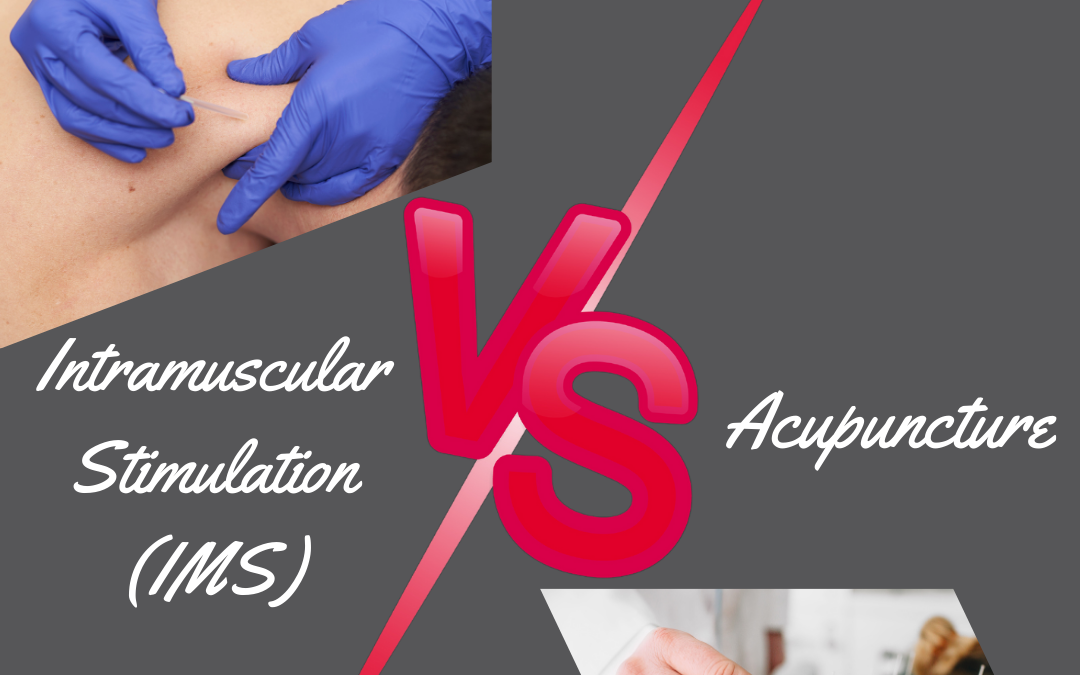
Therapy Options Explained
Intramuscular stimulation (IMS or Dry Needling) and acupuncture stand out as prominent therapies for pain and musculoskeletal conditions in alternative medicine. Both involve the insertion of needles, yet they stem from entirely different philosophies and target conditions. Whether you’re a health enthusiast or someone exploring alternative treatments, understanding the nuances between IMS and acupuncture can guide your wellness choices more effectively.
Comparison of Treatment Techniques
IMS and acupuncture might appear similar at first—both use needles, after all—but the similarities end there. IMS is a treatment grounded in Western medical science, focusing on diagnosing and alleviating neuropathic muscle pain. It involves inserting needles into tight muscle bands or trigger points causing pain. There’s no traditional philosophy guiding the process; instead, it’s all about the physical release of muscle tension and its neurophysiological effects.
Conversely, acupuncture is an ancient Chinese practice based on the flow of Qi (energy) through meridians in the body. Practitioners insert needles at specific points along these pathways to restore balance and promote health. This method is less about targeting particular muscle knots and more about realigning the body’s energy systems.
Conditions Targeted by IMS and Acupuncture
The conditions treated by IMS and acupuncture often overlap but generally have different focuses. IMS primarily addresses chronic pain, especially when the cause is neuropathic or related to muscle knots and tension. It’s particularly effective for conditions like back pain, tennis elbow, and fibromyalgia.
Acupuncture, with its broader philosophical approach, tackles a wide array of ailments beyond just musculoskeletal issues. It is an effective treatment for everything from headaches and menstrual cramps to stress, anxiety, and even infertility. The evidence base for both treatments varies, with acupuncture having substantial research backing its effectiveness across various conditions.

Needle Type and Technique
IMS uses needles that are very similar to acupuncture but may be slightly thicker (.3mm vs .25mm) and can be inserted deeper into the muscle tissue. IMS targets trigger points or “knots” within muscles. You should feel a deep ache or a twitching sensation as the practitioner moves the needle up and down through the tightened band of muscle. This technique elicits a twitch response from the muscle, releasing tension.
Acupuncture needles, on the other hand, are slightly thinner and shorter, designed for minimal discomfort. Acupuncture aims to balance energy flow (qi) by inserting needles at precise points along the body’s meridians, offering a gentle therapeutic experience. The needles typically remain in place for the whole session. Gentle manipulations may accompany them to enhance the treatment’s energy-balancing effects.
Patient Experience of Pain or Discomfort Between IMS and Acupuncture
The experience of receiving IMS can be more intense due to the focus on eliciting muscle twitches. This might result in brief, acute discomfort when the needle hits a trigger point, often followed by immediate relief as the muscle relaxes.
Acupuncture aims for a relatively painless insertion, with patients sometimes not feeling the needle. Patients generally describe the experience as deeply relaxing, with occasional mild sensations of tingling or heaviness around the needle sites.

Practitioner Profiles
Practitioners of IMS are usually trained physiotherapists with specific certifications in this technique. They have a solid anatomy, physiology, and pathology background, applying this knowledge to identify and treat specific musculoskeletal issues through IMS.
Acupuncturists undergo extensive training in traditional Chinese medicine, including the theory of Qi, meridians, and the holistic view of the body. In British Columbia, acupuncturists need licensure to meet professional standards for safe, effective treatment.
Similarities Between Acupuncture and IMS
Despite their differences, both therapies share common ground in their holistic approach to health, focusing on treating the body as a whole rather than isolated symptoms.
- Pain Management: Both are effective in managing various types of pain, from musculoskeletal issues to chronic headaches and stress-induced discomfort.
- Holistic Approach: They view health and wellness comprehensively through the lens of energy flow and balance in acupuncture or muscle function and nerve health in IMS.
- Individualized Treatment: Treatments are highly tailored, with practitioners adjusting their approach based on each patient’s unique condition and needs.

Conclusion
While IMS and acupuncture both offer benefits for various conditions, the choice between them comes down to individual needs and treatment goals. IMS often suits those with specific, localized muscle pain seeking relief with a foundation in Western medical principles. Acupuncture might appeal more to those looking for a holistic approach to wellness, encompassing physical, mental, and emotional health.
Before deciding, consult with professionals in both fields to discuss your concerns and treatment expectations. With knowledge and professional advice, you’ll be better placed to choose the therapy that best aligns with your wellness path.
Written by: DeVera Nybo, MBA, Owner Newleaf Total Wellness Centre

Conditions We Treat
Chronic pain—a phrase that millions of people across the globe know all too well. Chronic pain is not just a symptom. It’s a constant companion that affects every aspect of life. But what if there were ways to manage and potentially reduce this pain? What if you could address root causes instead of masking pain with medication? This blog post will explore the nature of chronic pain, its causes, and holistic approaches to treatment that go beyond traditional medicine.

Understanding Chronic Pain
Chronic pain is pain that persists for more than three months, often despite medication or treatment. It can stem from various conditions, including arthritis, back problems, migraines, or countless other health issues. Unlike acute pain—a body’s method of signalling harm—chronic pain can linger long after the injury has healed. Chronic pain hints at the complex interplay between the body and the brain.
The Terrible Triad: Suffering, Sleeplessness, Sadness
Chronic pain often brings along unwelcome companions—suffering, sleeplessness, and sadness, forming a ‘terrible triad‘. This triad creates a vicious cycle where pain worsens sleeplessness and sadness, which in turn can increase the perception of pain. Understanding this interconnection is crucial in managing chronic pain effectively.

The Brain’s Role in Chronic Pain
The brain plays a pivotal role in the perception and variation of pain. It acts as the central processing unit where pain signals are interpreted and experienced. Far from being a simple response to physical injury, pain involves complex exchanges between neural pathways. When an injured part of the body pain sends a pain signal, it travels through the nervous system to the brain. Here, the thalamus, cortex, and limbic system, analyze the signal, and process pain’s emotional and cognitive aspects.
This means that your emotional state, cultural background, and earlier experiences can significantly influence how you feel and manage pain. Furthermore, the brain can lessen the perception of pain by releasing natural painkillers, such as endorphins. The brain plays a critical role in the perception of pain and the body’s ability to suppress it. Understanding the brain’s role in pain perception opens avenues for new pain management strategies. Incorporating strategies that target neural systems, offers hope for chronic pain sufferers.
Seeking Natural Relief for Chronic Pain
For those who have been through the wringer of medical treatments and are wary of the side effects of traditional pain medications, there’s hope in natural therapies. These treatments aim to relieve pain and restore overall well-being.
Physiotherapy
Physiotherapy offers a pathway to improved quality of life through expert-led, personalized treatment plans. This science-backed approach addresses the discomfort and dives into the root causes of chronic pain. By integrating various techniques, from manual therapy to tailored exercise programs and education on body mechanics, physiotherapy empowers individuals with the tools they need to manage their pain effectively. It’s about more than symptom relief; it’s about fostering a partnership between patient and therapist to build a foundation for a more active and pain-free lifestyle. Through an empathetic and educational lens, physiotherapy helps patients understand their body and take proactive steps towards health.
Chiropractic Care
Chiropractic care is both holistic and non-invasive. At the heart of this practice is a profound understanding of the body’s intricate systems and how they can be harmonized for health. Chiropractic treatments can alleviate pain by improving the functional mobility of the joints and spine, reducing nerve irritation. This method addresses the symptoms and targets the underlying issues, fostering a healing environment within the body. If you need a break from the relentless grip of chronic pain, chiropractic care offers a promise. Chiropractors help patients reclaim control over their well-being, emphasizing the body’s innate ability for self-healing and resilience.
Acupuncture
Acupuncture involves the insertion of ultra-thin needles into specific points on the body. Researchers believe this technique stimulates the nervous system and activates the release of the body’s natural painkillers. For many sufferers of chronic conditions, such as arthritis, back pain, and migraines, acupuncture offers a pathway to relief without the reliance on pharmaceuticals. By engaging the body’s healing mechanisms, acupuncture reduces pain and improves overall well-being. It’s a testament to the power of integrating traditional healing practices with modern medical understanding, empowering individuals to explore alternative, non-invasive options for pain management.

Manual Osteopathy
Manual Osteopathy is a hands-on approach to healthcare emphasizes the body’s innate ability to heal, focusing on restoring balance and promoting overall wellness. Practitioners engage with the body’s structure and function to alleviate pain and enhance mobility. This method addresses the symptoms and dives deep to find and treat the root causes of pain. By adopting a holistic perspective, osteopathy empowers individuals, offering them a pathway to reclaim their quality of life without relying solely on medication.
Naturopathic Medicine
Naturopathic doctors are playing an increasingly pivotal role in the lives of those suffering from chronic pain, where traditional medicine often reaches its limits. By considering the entire individual—physically, emotionally, and mentally—naturopathy seeks to ease symptoms, identify and treat the root causes of pain. This method differs from the conventional model, focusing on symptom management often through pharmaceuticals, which can sometimes lead to dependency or unwanted side effects. Through personalized treatment plans that may include dietary changes, herbal medicine, physical therapies, and stress reduction techniques, naturopathic doctors empower patients to take charge of their health and well-being.

Massage Therapy
Massage therapy goes beyond mere relaxation, targeting the root of pain to foster healing and provide relief. By improving circulation, massage therapy helps the body’s natural recovery process, nourishing tissues starved of nutrients and oxygen due to prolonged tension and inflammation. Furthermore, it plays a crucial role in releasing endorphins, the body’s natural painkillers. Significantly, it also aids in reducing stress and anxiety, which are often intertwined with chronic pain. Through skilled manipulation of muscles and tissues, massage therapy alleviates discomfort. It empowers individuals to engage more fully in their daily activities, improving their quality of life.
Counselling
Psychotherapy and hypnotherapy can address the emotional and psychological aspects of chronic pain, breaking the cycle of the ‘terrible triad.’ Chronic pain is a complex and multifaceted condition, changing the physical body and the emotional and psychological well-being of those affected. Counselling offers a vital lifeline, providing strategies and support to help individuals cope more effectively with their pain. It goes beyond symptom management, addressing the profound emotional strain that chronic pain can impose. Through counselling, patients learn resilience-building techniques, mindfulness practices, and cognitive-behavioural strategies, empowering them to reclaim their lives from the clutches of pain.

Nutritional Counselling
For individuals grappling with chronic pain, the search for relief often leads down various paths, from medication to physical therapy. Yet, one avenue that may not be immediately obvious is nutritional counselling. Healthcare professionals are increasingly recognizing that our food can profoundly affect our body’s inflammatory processes and pain response. By working with an expert who understands the complex relationship between diet and chronic pain, sufferers can learn how to make informed dietary choices.
Food is medicine. Certain foods help reduce inflammation, enhance healing, and alleviate some of the discomfort associated with chronic conditions. This method does not stand as a solitary solution but rather complements other treatments, offering a holistic strategy to empower individuals to control their health and well-being. Through education and personalized guidance, nutritional counselling is vital in managing chronic pain, underscoring the significant role that diet plays in our overall physical health.
A Personal Journey of Managing Chronic Pain
Consider the story of a 70-year-old woman who walked into Newleaf Total Wellness Centre, lost and overwhelmed by three decades of chronic pain. After her physician left his practice and closed his clinic, she was suffering from medication withdrawals, and was desperate for a new approach. At Newleaf, she found a team ready to listen and tailor a comprehensive plan to address her pain holistically. Today, she enjoys a clearer mind and a more manageable pain level, proving it’s never too late to seek help and regain control over one’s life.

How Newleaf Can Help Combat Chronic Pain
At Newleaf Total Wellness Centre, we understand that every chronic pain sufferer’s story is unique. Our interdisciplinary approach, founded on patient-centred care, combines various treatments to help our patients become stronger, braver, and better. Whether at the beginning of your pain management journey or seeking alternative therapies, our team guides you toward a higher quality of life. It doesn’t matter where you start. Take the first step, and we will guide the ones that follow.
If you or someone you know is struggling with chronic pain, remember there is hope. Holistic approaches to pain management can offer relief and a pathway to a more vibrant, fulfilling life. Book a consultation to learn more.
Written By: DeVera Nybo, MBA, Owner, Newleaf Total Wellness Centre
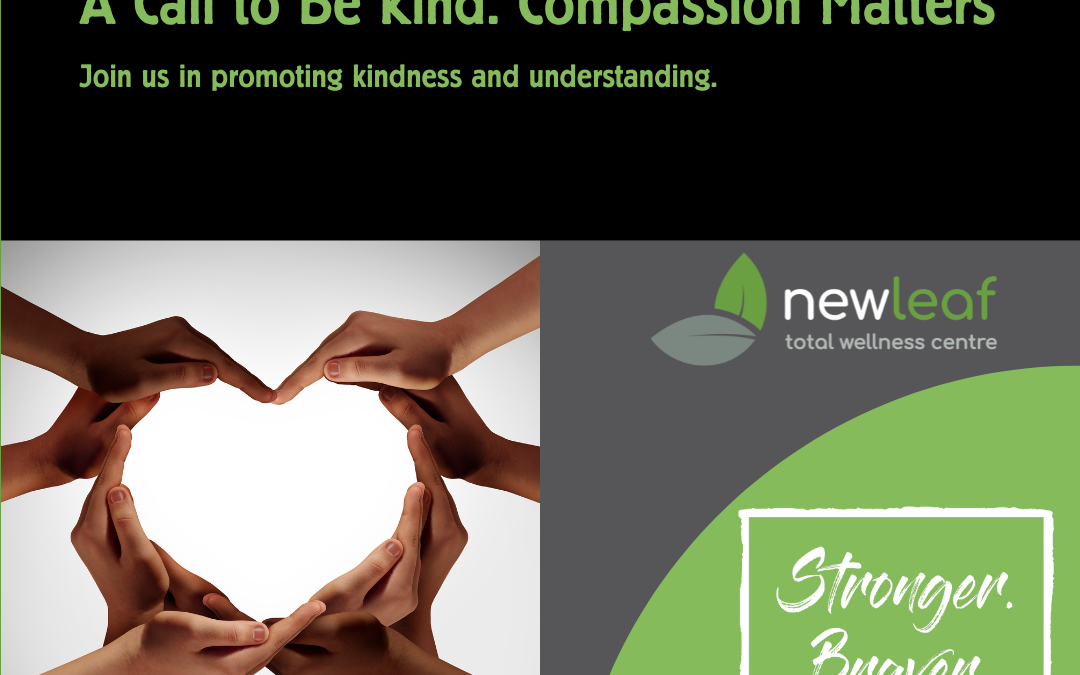
Mental Health and Emotional Wellness
As we approach Mental Health Week, scheduled from May 6 to 12, 2024, we must delve into the profound impacts of empathy and understanding in our lives. This year, the Canadian Mental Health Association‘s theme, ‘The Healing Power of Compassion’ invites us to recognize kindness as an intrinsic aspect of our humanity, capable of bridging divides and soothing wounds in a world often marked by suffering.

Everyone Struggles with Mental Health Sometimes
It’s a universal truth that everyone, at some point, faces challenges. Mental health is no exception. Society’s evolving understanding reveals a crucial acknowledgment: seeking support through therapy is not exclusive to those diagnosed with a mental illness. Therapy emerges as an accessible option for anyone navigating life’s complexities, whether deciding on a pivotal life change, mending relationships, or striving for personal growth.
Brené Brown, a luminary in the discourse on vulnerability, articulates this sentiment perfectly: “When we’re willing to show up, be seen, and own our stories, we pave the way for others to do the same. By fostering a culture of vulnerability and empathy, we can build stronger communities, organizations, and relationships.” Her words underscore the essence of this year’s theme, illustrating how our shared experiences of struggle and resilience can unify us.

Challenging Stigma with Understanding
For too long, the stigma encircling mental health has deterred individuals from seeking the help they deserve. Addressing and diminishing this stigma demands concerted efforts from all of us. Through openly sharing personal stories and experiences, we normalize discussing mental wellness issues, acknowledging their ubiquity across society. Education plays a pivotal role in challenging entrenched stereotypes and misconceptions, replacing them with facts and fostering an environment of empathy.
Furthermore, advocating for respectful and inclusive language when addressing mental health is critical, underscoring the dignity of every individual’s experience. Encouraging professional support and affirming that seeking help is entirely acceptable are fundamental steps toward eradicating stigma.

A Call to Compassion
Compassion reminds us of our shared humanity in a world that often demands grit and resilience. It beckons us to extend kindness to others and ourselves, illuminating the path toward a future where mental health is embraced with open arms and open hearts.
As we honour Mental Health Week, let us remember that compassion for ourselves and others can catalyze genuine healing and connection. If you or someone you know is navigating the complexities of life’s challenges, consider booking a therapy session with someone on our Mental Health team or sharing this message of hope and understanding.
Written by: DeVera Nybo, MBA, Owner, Newleaf Total Wellness Centre.
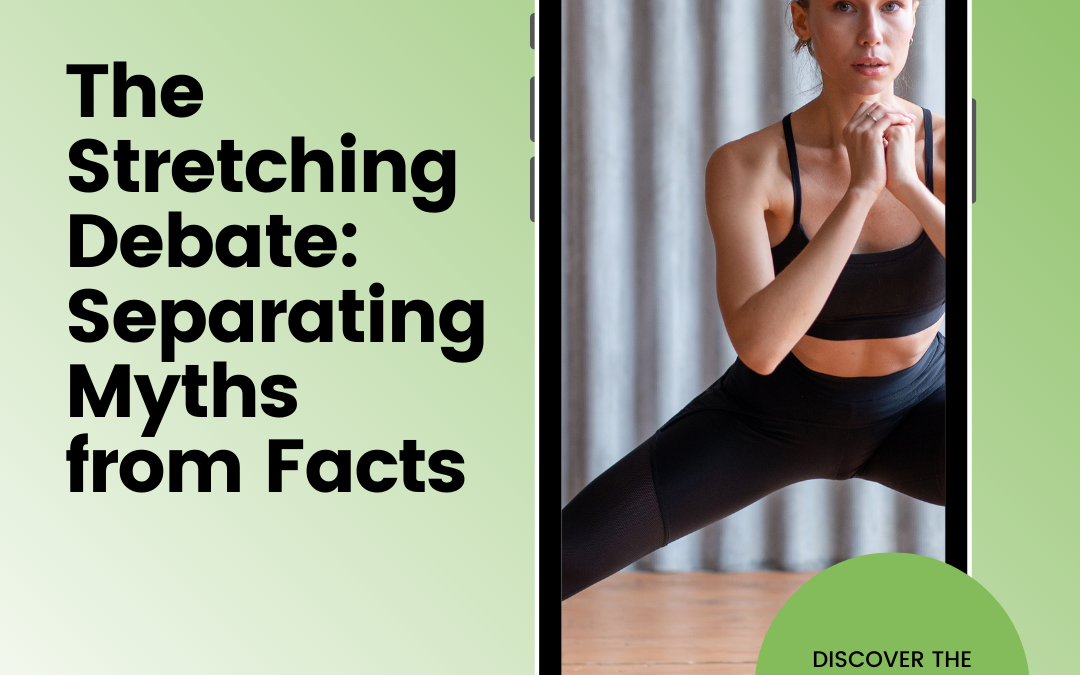
Injury Rehab and Prevention
In the fitness world, few topics have sparked as much debate as the effectiveness and application of stretching. For weekend warriors to elite athletes, the quest for optimal performance and injury prevention has often led to conflicting advice about warm up and cool down routines. Today, we’re dissecting the myths and facts surrounding stretching to empower you with a deeper understanding and a customized approach to enhancing your fitness regimen.
A Closer Look
Stretching, in its many forms, is a foundational element of physical activity. Still, misconceptions abound, leading to widespread debate about its utility and execution. Here’s what you need to know about static and dynamic stretching:

Static Stretching
- Definition: Extending a muscle to its fullest length and holding the position.
- Applications: Best used post-exercise for increasing flexibility and aiding recovery.
- Biomechanical Impact: Improves connective tissue elasticity, potentially reducing injury risk.

Dynamic Stretching
- Definition: Making controlled, active movements that stretch the muscles to their full range of motion
- Benefits: Enhances immediate performance and effectively warms up muscles by mirroring the activity to come.
- Recommendation: Ideal before exercises, a safer method to prep the body for dynamic actions.

Ed Middleton, Physiotherapist
Demystifying Common Myths
Myth 1: The Ultimate Injury Preventive Measure
Contrary to popular belief, the role of stretching in injury prevention is nuanced. While it can be beneficial, its effectiveness depends on the activity, the type of stretches performed, and an individual’s fitness level. Blanket statements about its efficacy overlook the complexity of human biomechanics and the specificity of sports demands.
Myth 2: All Stretching is Equally Beneficial
The reality is that stretching needs to be purposeful. Aimless stretching without a clear goal—improving flexibility, enhancing performance, or facilitating recovery—is unlikely to yield significant benefits. Your unique physical requirements and fitness objectives should inform how, when, and why you stretch.
Myth 3: One-Size-Fits-All in Warm-Ups and Cool-Downs
This notion fails to account for individual variances in physiology and fitness goals. For example, a gymnast may gain from prolonged static stretches to enhance muscle length. At the same time, a sprinter might prioritize dynamic stretches to maintain muscle responsiveness. The key is aligning your stretching routine with your activity profile and personal needs.

The Case for a Customized Approach
Acknowledging the pivotal role of customization underscores the crux of our discussion. A tailored stretching regimen, attuned to your specific physical attributes and aspirations, is the most effective strategy for leveraging stretching’s benefits. This approach encompasses the selection of appropriate stretches and the integration of strength and stability exercises to bolster overall mobility and performance.
Why Professional Guidance Matters
Given the evolving landscape of stretching research, professional insight is invaluable. Specialists like kinesiologists, physiotherapists, and chiropractors can demystify the complexities of stretching, offering tailored recommendations that resonate with your physiological profile and fitness targets.
The Power of Personalization
The stretching debate ultimately reveals a broader truth about fitness: any regimen must be personalized to realize maximum effectiveness. By considering the latest science, acknowledging individual differences, and opting for informed, specialized guidance, athletes and fitness enthusiasts alike can unlock stretching’s true potential—enhancing flexibility, performance, and overall well-being on their terms.
In conclusion, as we unravel the myths surrounding stretching and move towards a more nuanced understanding, the role of informed, personalized strategies becomes clear. Incorporating stretching into your fitness regimen should not follow a cookie-cutter approach but rather a thoughtful, individualized plan that acknowledges your body’s unique needs and the demands of your chosen activities. To get started on a personalized plan, book your initial assessment today.
Written by: DeVera Nybo, MBA, Owner Newleaf Total Wellness Centre.
Therapy Options Explained
In British Columbia, accessing healthcare has become a growing challenge for many residents. A staggering 59% report difficulties finding a family doctor, and many of these individuals are on waiting lists for a week or more. The average wait at a walk-in clinic has now reached 58 minutes, which is more than double the national average. Patients presenting with increasingly complex conditions, compound this issue, making a multifaceted approach to healthcare necessary. Enter paramedical services.
Amid ongoing healthcare difficulties, preventative medicine and paramedical services stand out as a source of optimism. The impact these services have in lightening the load on the healthcare system is enormous. Adopting preventative care tactics makes it possible to lessen the need for medical treatments.
By preventing diseases before they occur, we can alleviate the strain on our healthcare system and improve the quality of life for countless individuals.

Paramedical Services: Allies in Prevention
Paramedical services are instrumental in the preventative care framework. Services such as physiotherapy, chiropractic care, nutritional counselling, and acupuncture enhance recovery and well-being and often circumvent the need for more extensive medical interventions. Additionally, they embody a holistic view of healthcare, emphasizing the importance of treating the whole individual rather than focusing solely on symptoms. Early engagement with these services can significantly reduce hospital admissions and the demand for emergency departments.
- Physiotherapy helps prevent musculoskeletal issues and enhances mobility, fostering quicker recovery from injuries or surgeries.
- Chiropractic Care emphasizes spinal health and pain management, potentially reducing the necessity for pain medication and invasive treatments.
- Nutrition Counseling provides education on healthy eating habits and managing and preventing chronic conditions like diabetes and heart disease.
- Psychology and Counseling services play a pivotal role in crisis prevention, stress management, and promoting overall mental health.
- Massage Therapy and Acupuncture offer pain relief, reduce stress, and contribute to overall health, complementing conventional treatments
- Naturopathic Doctors can recommend and prescribe essential nutrients like vitamin B12 and folate, which play a crucial role in wellness. Deficiencies in such nutrients can lead to significant health complications, underscoring the importance of a proactive approach to health that prioritizes nutrition, exercise, and stress management.

The Path Forward
Our healthcare system faces unprecedented challenges and clearly requires innovative solutions. Preventative medicine, underscored by the vital contributions of paramedical services, represents a promising avenue toward a sustainable future in healthcare. Collaborative efforts between primary care providers, specialists, and community-based services are crucial in streamlining care, preventing hospital readmissions, and optimizing the utilization of resources.
Educating the public and advocating for integrated healthcare models can shift the reactive to proactive health management paradigm. By emphasizing prevention, early intervention, and collaborative care, we can address the underlying factors driving the healthcare crisis and forge a healthier, more resilient society.
The Newleaf Total Wellness Centre stands at the forefront of this crucial endeavour, embodying the principles of interdisciplinary collaboration and preventative care. Together, we can transform the healthcare landscape in British Columbia and beyond, ensuring a more robust, healthier future for all. Book an appointment to see what a difference our services can make for you.
Written By: DeVera Nybo, MBA, Newleaf Total Wellness Centre

Women's and Children's Health
Stepping onto the scale can sometimes feel like a rollercoaster ride, unpredictable and unnerving, especially if you’re trying to maintain or manage your weight. However, before you get discouraged by the ups and downs, it’s essential to understand why weight fluctuations happen. This blog post will explore five reasons behind these daily changes and provide insights for health enthusiasts and dieters.

How Dehydration and Water Retention Affect Your Weight
One might think drinking less water could help weight loss; however, the opposite is true. Dehydration can cause the body to hold onto water, leading to water retention. This survival mechanism is the body’s way to ensure adequate hydration. To avoid these fluctuations, drink the recommended amount of water daily – your body (and the scale) will thank you.

The Impact of Sodium Intake on Your Weight
Sodium intake plays a tricky role in our bodies. Sodium is vital for nutrient transport and blood pressure regulation. Yet, too much of it can lead us down the path of water retention and weight gain. Processed foods are often the culprit of high sodium levels, so keeping an eye on salt intake can prevent those surprise numbers on the scale.

Glycogen Storage
Carbohydrates aren’t the enemy—they’re converted into glycogen to fuel our cells. But when we consume more carbs than we need, the body stores the excess as glycogen in our muscles, liver, and fat cells. Each gram of glycogen comes with water, causing weight fluctuations. Balancing your carb intake with your energy needs can stabilize these shifts in weight.

Changes in Body Waste
The amount of food and drink we’ve recently consumed can temporarily influence the scales. We cannot overlook urine and stool when we discuss body weight. After all, the average adult passes about 128 grams of stool per day. A high-fibre diet and regular hydration can keep things moving smoothly, ensuring that the number reflected on the scale isn’t just an undigested lunch.

How Exercise Affects Your Weight
Finally, if you’ve recently taken up a new exercise routine, you might see fluctuations on your scale as your body adjusts. Exercise leads to muscle gain, which weighs more than fat and changes the body’s water composition. This gain is a good thing—a sign of improved fitness and metabolism—so don’t be discouraged if you see increases as you build muscle.
Conclusion
Several factors influence body weight, and it’s common to see daily changes. We can approach weight management with knowledge and patience by understanding these contributors—hydration, dietary choices, energy stores, waste elimination, and muscle development. Remember, the number on the scale is not the sole indicator of your health or fitness progress. It’s the day-to-day choices we make that shape our health and well-being. So, keep moving, stay hydrated, and nourish your body with whole foods – the rest will fall into place.
Additional Tips for Weight Management
- Don’t fixate on daily weight changes; focus on long-term trends.
- Prioritize whole foods and limit processed, high-sodium options.
- Stay hydrated throughout the day to avoid dehydration and water retention.
- Incorporate a mix of cardio and strength training for overall health benefits.
- Consult a healthcare professional for personalized advice and support.
- Find an exercise routine that you enjoy and can stick to long-term.
- Don’t restrict yourself too much – allow for occasional treats in moderation.
- Practice mindful eating, focusing on hunger and fullness cues instead of strict calorie counting.
- Remember that weight is not the only measure of health – focus on how you feel physically and mentally. It’s not just about the number on the scale but overall wellness.
Written by: DeVera Nybo, MBA, Owner, Newleaf Total Wellness Centre

Conditions We Treat
Experiencing numbness, tingling, or burning in your extremities can be discomforting and, at times, alarming. Often called “pins and needles,” these sensations can occur for various reasons, from sitting in one position for too long to more serious underlying health conditions. At Newleaf Total Wellness Centre, we understand the complexities of these symptoms and advocate for a comprehensive, patient-centred approach to diagnosis and treatment.

Numbness, Tingling and Burning OR Pins and Needles
Pins and needles, medically referred to as paresthesia, can range from mild and intermittent to severe and chronic, influencing the quality of life. The origins of these sensations are diverse, from poor circulation to certain neurological diseases. Given this variety, a multidisciplinary approach is often the key to unlocking effective treatment strategies and long-term relief.
- Nerve compression: Prolonged pressure on a nerve, as experienced when sleeping on an arm all night, can lead to temporary numbness and tingling.
- Neuropathy: Damage to nerves, often from conditions like diabetes, can cause chronic symptoms.
- Circulatory issues: Poor blood circulation can make your limbs feel cold and numb or even lead to a burning sensation.
- Nutrient deficiencies: Lack of vitamins like B12 can affect nerve health and contribute to these uncomfortable sensations.
- Injuries: Trauma to nerves, such as from an accident, can result in acute or long-term symptoms.
- Neurological diseases: Conditions like multiple sclerosis or stroke can manifest as numbness or tingling in the limbs.

Dr. David Veltman-Robert, Chiropractor
The Role of Interdisciplinary Care in Resolving Numbness
Given the variety of potential causes, it’s no surprise that a multidisciplinary approach may be necessary. Here’s how specialists from different healthcare streams can contribute:
Chiropractors
Chiropractic care focuses on diagnosing and treating neuromuscular disorders, primarily through manual adjustment or manipulation of the spine. For patients experiencing numbness and tingling, chiropractors can help by relieving pressure on the nervous system, improving spinal movement function, and enhancing nerve communication.
Physiotherapists
Physiotherapy aims at restoring, maintaining, and making the most of a patient’s mobility, function, and well-being. Through a combination of exercises, hands-on therapy, and education, physiotherapists can strengthen the body’s musculoskeletal system, improve circulation, and reduce nerve compression.

Ed Middleton, Physiotherapist
Acupuncturists
Acupuncture, an ancient Chinese medicine practice, involves inserting fine needles into specific points on the body. It stimulates the body’s natural painkillers and increases blood flow. For those experiencing paresthesia, acupuncture can effectively alleviate pain, reduce inflammation, and promote nerve health.
Manual Osteopaths
Manual osteopathy involves using gentle hands-on techniques to restore optimal body function. Osteopaths assess and treat movement restrictions in your body tissues that prevent you from being healthy and fit. Their approach can significantly benefit individuals with numbness and tingling by enhancing blood circulation and decompressing areas around affected nerves.
Finding Relief for Numbness, Tingling and Burning: Simple Steps
While professional help is sometimes necessary, there are simple lifestyle adjustments you can make that may provide relief:
- Regular exercise to improve circulation
- Change positions frequently to reduce nerve compression
- A balanced diet to prevent nutrient deficiencies
- Mindful habits to reduce stress and enhance overall nerve health
However, seeking medical advice is crucial if you’re experiencing persistent, recurring, or severe symptoms.

Recognizing When Numbness, Tingling and Burning is Serious
While experiencing occasional pins and needles is common and usually harmless, persistent or severe symptoms require immediate attention. If you experience paresthesia alongside symptoms such as muscle weakness, difficulty moving, or changes in bowel and bladder function, it’s crucial to seek emergency medical attention. These could be signs of a more severe condition, like a stroke or spinal cord injury.
Taking the First Step
Living with numbness, tingling, and burning in your extremities doesn’t have to be your norm. At Newleaf Total Wellness Centre, we empower our patients through education and proactive and preventative care. By understanding the root cause of your symptoms and leveraging our team’s interdisciplinary expertise, we can create a personalized treatment plan that addresses your unique needs.
Remember, your path to a higher quality of life begins with a single step. If you’re ready to explore how our team can assist you in managing or overcoming pins and needles, we invite you to partner with us. Together, we can work towards achieving your goals for a healthier tomorrow. Book a consultation.
Written by: DeVera Nybo, MBA, Owner, Newleaf Total Wellness Centre

Conditions We Treat
Bursitis is a condition that doesn’t discriminate. Whether you’re an athlete pushing your body to its limits, part of our wiser elderly population experiencing the trials of age, or simply someone going about their daily life, the risk of encountering bursitis is real. But with an understanding of what bursitis entails, its causes, and the treatments available, we can empower ourselves to prevent or manage this condition effectively.
What is Bursitis?
Bursitis is the inflammation of the bursae, tiny, fluid-filled sacs throughout our bodies. These sacs act as cushions, reducing friction between bones and soft tissues and creating smooth, pain-free movement. When these bursae become inflamed, movement can become painful and challenging, affecting your quality of life.

Finding the Causes of Bursitis
Bursitis can result from various activities and conditions that put excessive pressure on the bursae over time. This includes repetitive motions or positions that irritate or pressure the bursae. Athletes, for instance, often get bursitis in joints that perform frequent repetitive motions, such as the shoulder, elbow, or knee.
Age is another factor, as wear and tear on the bursae increase over the years. Additionally, traumatic injuries can cause immediate bursitis, and certain systemic diseases, such as rheumatoid arthritis or gout, can predispose individuals to inflammation of the bursae.
Cures and Treatments
Fortunately, there are multiple routes to alleviating the discomfort of bursitis. Non-prescription anti-inflammatory drugs (NSAIDs) can reduce pain and swelling. Applying ice to the affected area during the first stages of pain can also help manage inflammation.

Acupuncture for Bursitis Relief
Acupuncture is a therapy recognized for its analgesic effects. By targeting specific points based on the location of your bursitis—whether in the hip, knee, or shoulder—acupuncture can reduce inflammation and stiffness while promoting the drainage of excess fluids. This method uses the body’s natural pain-relief mechanisms, including the release of endorphins, to provide significant relief.
Traditional Chinese Medicine (TCM)
TCM practices such as acupressure and Chinese herbal therapy may help combat bursitis. Corydalis Analgesic Tablets, aloe vera, herb plasters, and herbal teas with meadowsweet, horsetail, and willow bark are some treatments used to alleviate pain and inflammation. The personalized combination of these therapies can offer holistic relief from the symptoms.
The Power of Hydrotherapy and Homeopathy
Alternating hot and cold compresses—an easy-to-follow hydrotherapy method—can remarkably help bursitis patients. Homeopathic remedies like Ruta graveolens have also shown promise in easing the discomfort associated with the condition.

Massage Therapy for Bursitis
A skilled therapist provides massage treatments to relieve bursitis’s acute and chronic symptoms, especially in the shoulder. Techniques such as gentle Swedish massage strokes, kneading, and trigger point massage reduce inflammation, improve range of motion, and soothe related stress and anxiety. These methods target the pain and encourage healing by increasing circulation and breaking down scar tissue.
Chiropractic Care
Joint manipulation offered by our chiropractic care specialists can loosen soft tissues, restore flexibility, and relieve pressure on the affected bursa. Chiropractic adjustments can provide considerable relief when combined with physiotherapy treatments like ultrasound and shockwave stimulation.

Physiotherapy: The Frontline of Bursitis Management
Typically, the first approach to managing bursitis involves physiotherapy. This non-invasive treatment focuses on strengthening the muscles surrounding the affected joint, alleviating pain and preventing future occurrences. Physiotherapy exercises, tailored to individual needs, play a crucial role in recovery, often spanning approximately 4 to 6 weeks. Your physiotherapist may prescribe specific exercises to prevent bursitis from progressing to more severe conditions like frozen shoulder syndrome.
Corticosteroid Injections: A Closer Look
Your doctor may recommend corticosteroid injections if other treatments do not fully resolve your symptoms. Esteemed for their ability to provide rapid relief from pain by reducing inflammation, these injections are particularly effective in treating conditions like trochanteric bursitis, commonly seen in older adults. However, it’s important to note that the benefits of corticosteroid injections tend to be temporary, and excessive use might lead to tissue damage.
The Balance Between Immediate Relief and Long-Term Health
It’s crucial to understand that corticosteroid injections offer quick pain relief but don’t address bursitis’s root cause. This is where the expertise of our interdisciplinary team at Newleaf Total Wellness Centre becomes invaluable. We emphasize a holistic approach, combining immediate relief methods with long-term rehabilitation through physiotherapy. This blend aims to improve joint function, enhance muscle strength, and correct posture and ergonomic issues, paving the way for sustainable healing.

An Individualized, Collaborative Approach
Our treatment plans are highly personalized, recognizing the unique nature of each case of bursitis. We consider a range of factors, including the severity of symptoms, patient preferences, and overall health, ensuring that we address every aspect of your condition. Collaboration is at the heart of our practice; physiotherapists work closely with specialists such as orthopedic doctors, rheumatologists, and pain management experts to ensure comprehensive care.
Understanding Bursitis Prevention
The key to preventing bursitis is minimizing the stress placed upon your joints—a critical consideration for athletes, professionals, or individuals whose daily activities involve repetitive motions. Here are essential strategies to incorporate into your routine to shield your joints from undue strain:
- Employ Proper Techniques
Applying the correct techniques is fundamental whether you’re engaging in sports or repetitive work tasks. This might include adjusting your posture or changing your approach to physical activities to distribute pressure more evenly across your joints.
- Incorporate Regular Breaks
Taking regular breaks during prolonged activity helps alleviate pressure on the bursae. Short rest intervals can be remarkably effective in preventing the onset of bursitis by giving your joints time to recover from continuous stress.
- Strengthen Supporting Muscles
Exercises tailored to bolster muscle groups relevant to your daily activities can support your joints. By strengthening these muscles, you enhance your overall physical health and reduce the burden on your joints, mitigating the risk of developing bursitis.
- Maintain a Healthy Weight
Extra weight can exert added pressure on weight-bearing joints, such as the knees and hips, increasing the likelihood of bursitis. Maintaining a healthy weight through balanced nutrition and regular exercise minimizes this risk.
- Opt for Anti-inflammatory Nutrition
Inflammation is a core part of bursitis, so making dietary choices that fuel or fend off inflammation is incredibly impactful. Working with a holistic nutritionist to develop meal plans that avoid inflammatory foods while being enjoyable and sustaining can play a pivotal role in preventing bursitis. Tailored nutrition supports joint health and helps your overall wellness.
Conclusion
In wrapping up our comprehensive discussion on bursitis, it’s clear that this condition touches many lives, irrespective of age or lifestyle. However, our knowledge about bursitis—its causes, treatments, and preventive measures—illuminates a path forward that can help manage and even prevent this painful condition.
At Newleaf Total Wellness, we believe in empowering our clients with knowledge and offering a multidisciplinary approach to treatment that addresses the root causes, not just the symptoms. Bursitis, though common, doesn’t have to be a condition that limits your quality of life. Individuals can return to daily activities comfortably and efficiently with the right approach, guidance, and care.
Remember, every step to understanding and caring for your body is a step towards a healthier, more active life. We’re here to support you on that journey, providing the expertise and care needed to move beyond pain and toward optimal well-being. If you are suffering with bursitis, book an appointment at Newleaf today!
Disclaimer
The content on the Newleaf Total Wellness Centre blog, including insights on various holistic health practices, serves purely educational purposes. Before adopting any new health regimen, including treatments or herbal remedies mentioned here, consult with a healthcare professional to ensure it’s suitable for you. Our blog does not substitute for professional medical advice, diagnosis, or treatment. We encourage meaningful discussions with your healthcare provider to secure the best care for your well-being.

Healthy Habits & Lifestyle
We’ve repeatedly heard that what we eat is crucial to our well-being. Yet, despite the best advice, the foods that enliven one person’s day can leave someone else feeling sick. It’s a reminder that nutrition is far from a “one-size-fits-all” concept. Our bodies are as unique as our personalities, responding differently to various diets.
Just as the nursery rhyme goes, Jack Sprat could eat no fat while his wife could eat no lean—a dynamic that might sound familiar to many. My partner thrives on a ketogenic diet, rich in healthy fats, moderate proteins, and low in carbs. In contrast, my body prefers a friendlier relationship with carbohydrates and tends to rebel against too much red meat. It’s important to recognize that even without food allergies, certain foods (yes, even “healthy” ones) might not suit our digestive systems, leading to discomforts such as bloating or nausea.
The evidence suggests that some foods, known for causing internal inflammation, can worsen conditions like asthma or arthritis. Reducing or cutting out these foods can help anyone looking to keep a balance in their body’s systems. In contrast, foods that combat inflammation can be universally nurturing.

Inflammation’s Impact on Health and Ability to Heal
‘Inflammation’ often conjures images of a swollen ankle or reddened, healing skin. Yet, it also reflects a more profound, sometimes silent, process within our bodies. Often lurking in the foods we eat, inflammation can be the silent enemy that compromises our health. Understanding the impact of inflammatory foods is critical for those striving toward a healthier lifestyle.
Consuming a diet rich in inflammatory foods can disrupt the natural healing process. Chronic inflammation can weaken immune system responses and delay recovery from injuries. Additionally, scientists have linked inflammation to a variety of diseases, including heart disease, diabetes, and certain types of cancer.
Weight Gain and Obesity
The relationship between diet-induced inflammation and weight gain is complex but critical. Foods that promote inflammation can disrupt the balance of gut bacteria and hormone levels and lead to insulin resistance—all factors that may contribute to weight gain and difficulty in losing weight. Addressing dietary inflammation may be a key strategy in managing and reducing obesity.

The Impact of Inflammation on Mood and Mental Health
Have you ever felt foggy or fatigued after a meal? The brain is extremely sensitive to dietary influences. People consuming diets high in inflammatory foods have an increased risk of depression and anxiety. Furthermore, there is growing evidence to suggest that consuming anti-inflammatory foods could improve mood and alleviate symptoms of certain mental health conditions.
Autoimmune Disorders
Autoimmune disorders, such as eczema, rheumatoid arthritis, and lupus, are characterized by the immune system mistakenly attacking the body. Inflammatory foods can worsen these conditions, leading to more discomfort and flare-ups. On the other hand, incorporating anti-inflammatory foods into one’s diet may help manage and reduce the severity of symptoms.

What are Some Signs of Internal Inflammation?
Inflammation likes to operate under the radar. Here are some hints that it might be working its mischief within you:
- Persistent Fatigue: Feeling tired is normal after strenuous activity, but ongoing, unexplained fatigue might signal an inflammatory response.
- Gastrointestinal Issues: Frequent bouts of diarrhea, constipation, or bloating can indicate inflammatory conditions of the digestive system, such as Crohn’s disease or ulcerative colitis.
- Excessive Mucus Production: Chronic inflammation can increase mucus production, particularly in respiratory conditions such as asthma and chronic sinusitis. You may also see mucus in your stool and sputum when you cough.
- Skin Problems: Certain skin conditions, such as psoriasis and eczema, have been linked to inflammation within the body. Chronic skin inflammation can also be an indicator of underlying autoimmune disorders.
- Joint Pain and Stiffness: Joint inflammation can cause pain, stiffness, and swelling, particularly in conditions like rheumatoid arthritis. Chronic inflammation often targets the joints, leading to pain, stiffness, or swelling that isn’t caused by a specific injury.
- Skin Problems: Conditions like eczema, psoriasis, and other chronic skin issues can indicate underlying inflammation within the body.

What Foods Cause Inflammation?
The culprits behind dietary-induced inflammation might be sitting quietly in your pantry or fridge. While we’ve outlined broad categories of inflammatory foods, remember that individuals might respond differently.
- Processed and Red Meats: High in saturated fats, processed meats like hot dogs, sausages, and bacon, as well as red meats such as beef, have been associated with increased inflammation markers in the body.
- Refined Carbohydrates: Foods made from refined flour, such as white bread, pastries, and many snack foods, can elevate blood sugar levels rapidly, leading to inflammation.
- Fried and Fast Foods: Not only are these foods typically high in unhealthy fats but frying also introduces advanced glycation end products (AGEs), compounds that can stimulate inflammation.
- Sugar-Sweetened Beverages: Soft drinks, fruit drinks, and other sweetened beverages are high in fructose and other forms of added sugar, contributing to insulin resistance and inflammation.
- Trans Fats: Although increasingly being removed from food products, trans fats found in margarine, fast food, and commercial baked goods can provoke inflammatory responses.
- Artificial Additives: Some artificial colours, flavours, and preservatives in processed foods may trigger inflammatory reactions in some individuals, particularly those with food sensitivities or allergies.

Nourishing Alternatives to Include
On the flip side, focusing on whole foods that support a balanced and vibrant body is essential. However, the hero in one person’s meal may be the inadvertent villain in another. Understanding your body’s unique reactions to foods, embracing intuitive eating, and prioritizing gut health are not just nods to modern wellness trends but imperatives for anyone looking to combat inflammation’s silent siege. Try eating:
- Leafy Greens: Spinach, kale, and Swiss chard have essential vitamins, minerals, and fibres. They support a healthy digestive system and are low in calories. Salads are your friend if you’re like me, but wilted or steamed greens sit better in the belly if you’re like my partner.
- Healthy Fats: Nuts, seeds, avocados, olive oil, and fish rich in Omega-3 fatty acids, such as salmon and mackerel, have healthy fats, which are essential for hormone production and nutrient absorption.
- Whole Grains: Swap your white bread and regular pasta with whole-grain alternatives. Whole grains are rich in fibre and can help regulate blood sugar levels.
- Fruits and Berries: Fruits are nature’s candy. They’re rich in fibre, antioxidants, and vitamins. Choose fresh or frozen varieties without added sugars.
- Lean Proteins: Incorporating lean proteins, like chicken, turkey, fish, and plant-based proteins, such as lentils and chickpeas, can build muscles and keep you full longer.

Strategies for Avoiding Inflammatory Foods Amidst a Hectic Lifestyle
For busy professionals, parents juggling responsibilities, or students managing coursework and jobs, the key to good nutrition often lies in simplicity and planning. Healthy eating doesn’t have to be a complicated affair.
- Meal Prep: Dedicate a part of your weekend to preparing meals for the week ahead. A couple of hours spent cooking can save you a multitude of time during the week.
- Snack Smart: Keep handy snacks like carrot sticks, almonds, or Greek yogurt within reach for those mid-day hunger pangs.
- Hydrate Healthily: Replace sugary beverages with water infused with fruits or herbs for a refreshing pick-me-up.
Remember
While there are categorical suggestions on what to avoid and what to consume, the most valuable lesson is listening to your body. It’s about finding harmony within and ensuring your dietary choices align with your body’s needs and goals. Integrating the principle of nutritional individuality into our diets means paying close attention to how we feel after meals. Does lentil soup leave you feeling energized or unexpectedly stodgy? Do raw vegetables soothe you or seem to dial up digestive despair? It boils down to inflammation—knowing, understanding, and mastering the subtler tongue of your body’s internal dialogue.
Empower yourself with the knowledge, respect your body’s responses, and commit to your overall health by making informed decisions about your food. It’s a path worth taking for your well-being. Let food be your medicine, not just calories to count.
# Bonus Tip:
Don’t be afraid to experiment with new foods and dietary habits. Our bodies constantly evolve, and what might have worked for us in the past may no longer suit our current needs. Be open-minded and curious about food, and don’t hesitate to adjust your diet as needed. Working with a Holistic Nutritionist can get you started with meal plans that suit your taste, lifestyle and dietary needs.
Disclaimer
The content on the Newleaf Total Wellness Centre blog, including insights on various holistic health practices, serves purely educational purposes. Before adopting any new health regimen, including treatments or herbal remedies mentioned here, consult with a healthcare professional to ensure it’s suitable for you. Our blog does not substitute for professional medical advice, diagnosis, or treatment. We encourage meaningful discussions with your healthcare provider to secure the best care for your well-being.
Written By: DeVera Nybo, MBA, Owner, Newleaf Total Wellness Centre.

Pain Relief and Physical Health
In your wellness journey, you may have encountered the bewildering phenomenon of referred pain, which manifests in areas distant from its source. It’s a complex puzzle, isn’t it? Yet, for those with chronic conditions, recovering from trauma, or navigating injuries, understanding this concept is a pivotal move towards empowerment and regaining control over your well-being.
The Pathways of Pain
It might surprise you to learn that some referred pain travels along specific nerve pathways. This means you may feel discomfort originating in one organ or place of the body entirely in another area. It’s a curious phenomenon in which the nervous system sends mixed signals about the location of the soreness, making it difficult for our brain to pinpoint the distress. Our bodies have a delicate network of nerves threaded throughout. Sometimes, the signals get crossed. Because of its deceptive nature, referred pain can be challenging to diagnose and treat, but understanding its principles is the first step toward managing it more effectively.

Patterns and Recognition
Not all referred pain is random; there are identifiable patterns. For instance, arm discomfort may signal heart complications. At the same time, aching in your shoulder blade might indicate issues with internal organs like the gallbladder or liver. In contrast, a throbbing knee may indicate low back issues, while headaches might originate in the cervical spine. As explained in “PMC,” these patterns act as guides, giving clues to uncover the main issue rather than providing a conclusive diagnosis. Therefore, it is advisable to seek advice from healthcare experts skilled at diagnosing and treating musculoskeletal expressions of pain.
Fascia: The Hidden Culprit
Beyond nerve pathways lies a lesser-known player in the pain game called the fascia. This web-like connective tissue envelops our muscles and organs. When strained, the aching can be mysterious, seemingly untraceable, and often mistaken for other ailments.
Understanding the role of fascia in pain perception highlights the need for a comprehensive approach to treatment that looks at the whole picture rather than isolated symptoms.

The Role of the Brain
Many people are surprised to learn that referred pain is not a result of the body’s physical structures but a product of the brain. Various factors, like our previous experiences, emotional state, and even cultural beliefs, influence this “pain map” within our brain.
Additionally, pain is not so much a sensation as a sophisticated perception forged in your mind. Consider this enlightening truth: physical suffering is often fully driven by the brain, making it a deeply subjective experience influenced by physical factors, memories, emotions, and even sensory triggers such as smells.
Influences That Shape How We Perceive Pain
Here lies the most profound revelation in our exploration of pain perception—we are not passive recipients of this sensation. Our past experiences, the stories we’ve heard, and the environment around us all shape how intensely we feel pain.
Remember a time when a familiar aroma alleviated some discomfort without any medication? That’s not magic; your neural network responds to positive associations. Similarly, stress can amplify our suffering, while tranquillity might diminish it. Thus, managing our environment and emotions is a major ally in our search for relief.

Cognitive Behavioral Therapy: Empowering Pain Management
Cognitive behavioural therapy (CBT) is an evidence-based psychological intervention that promotes self-awareness, emotional balance, and adaptive coping strategies. Researchers have widely documented the effectiveness of CBT for pain management. Studies consistently show its effectiveness in reducing symptoms and improving the overall quality of life for individuals suffering from chronic pain. Working with a psychotherapist or other counsellor may help patients understand and cope with their pain.
Articulating the Pain Experience
Your experiences are valid! The trick is translating them accurately to a healthcare professional so they can actually help you. Clear communication is crucial. When describing your condition, be as specific as possible. Describe the location, type of pain (sharp, dull, throbbing), frequency, intensity, and any activities that worsen or lessen it. This detailed portrait of your soreness assists professionals in piecing together a more accurate diagnosis. While filling out all those intake forms and repeatedly telling your story is tedious, they are essential to your patient history. The more information you can provide, the quicker your practitioner can solve the mystery of your pain.

Tailoring Treatments for Maximum Effectiveness
A one-size-fits-all approach to managing pain falls short of addressing each individual’s unique needs. Efficient management often requires a multidisciplinary team that includes practitioners with specialized training, physical therapy, acupuncture, visceral manipulation, nutrition, and psychotherapy to design personalized treatment plans. This holistic strategy ensures the improvement of symptoms. It aims to tackle the root cause of the discomfort, paving the way for sustainable recovery and wellness.
The Way Forward
In light of these insights, we extend you a beacon of hope: Manage your lifestyle. Seek professional guidance attuned to your physical symptoms and you as a complex and unique individual.
Keep this your mantra: patience and persistence are your trusted companions on this healing voyage. And remember, when it comes to conquering referred pain, understanding is half the battle won.
Stay empowered, well-informed, and positive as you break through the barriers of chronic pain and rediscover the joys of a vibrant, balanced life.
Your pain is real, but so is hope. With this affirmative note, we encourage you to act. After all, your wellness story is incomplete, and the next chapter is in your hands.

Conclusion
At Newleaf Total Wellness Centre, we understand the complexity of referred pain and its impact on our patients. We strive to help people heal from injuries, trauma, and illness to achieve optimal wellness through a holistic approach that prioritizes education, collaboration, and individualized treatment plans. With our team of dedicated professionals and a range of specialized services, we are committed to helping our patients find long-term relief and improve their overall quality of life. Don’t let referred pain hold you back – let Newleaf Total Wellness Centre help you on your journey towards a pain-free life. Book an appointment to discuss your unique needs.
Written by DeVera Nybo, MBA, Owner, Newleaf Total Wellness Centre
Disclaimer
This document is for informational purposes and is not a substitute for professional medical advice, diagnosis, or treatment. Always seek the advice of your physician or another qualified healthcare provider with any questions you may have regarding a medical condition, including pain.
References:
International Association for the Study of Pain (IASP). (n.d.). Referred Pain. Retrieved from https://www.iasp-pain.org/terminology?navItemNumber=576#Referredpain
PMC. (2015). Understanding the referred pain experience, Journal of Physical Therapy Science, 27(2), 555-556. doi:10.1589/jpts.27.555
Cognitive Behavioural Therapy for Chronic Pain. (2021). Retrieved from https://www.nhs.uk/conditions/cognitive-behavioural-therapy-cbt/treatment-for-pain/
National Center for Complementary and Integrative Health. (2019). Acupuncture: In Depth. Retrieved from https://www.nccih.nih.gov/health/acupuncture-in-depth
Visceral Manipulation Institute. (n.d.). What is Visceral Manipulation? Retrieved from https://www.barralinstitute.com/therapies/index.php
Heartland Health Research Institute. (2019). Manual Osteopathy: Holistic Approach for Pain Relief and More. Retrieved from http://heartlandhealthresearchinstitute.com/manual-osteopathy-holistic-approach-for-pain-relief-and-more/














































































 Neck Pain
Neck Pain Shoulder Pain
Shoulder Pain Foot/Ankle Pain
Foot/Ankle Pain










 .
.


























































